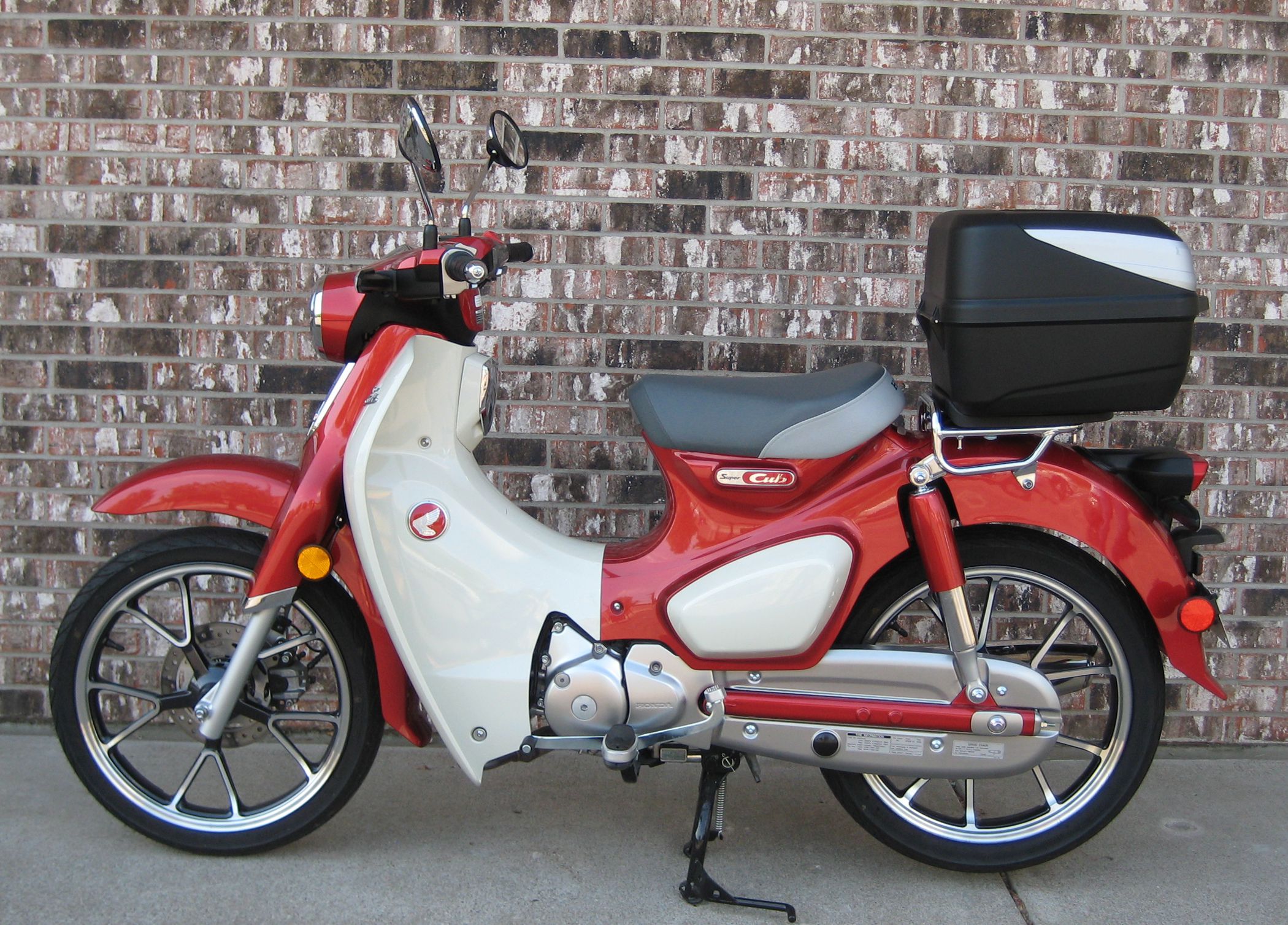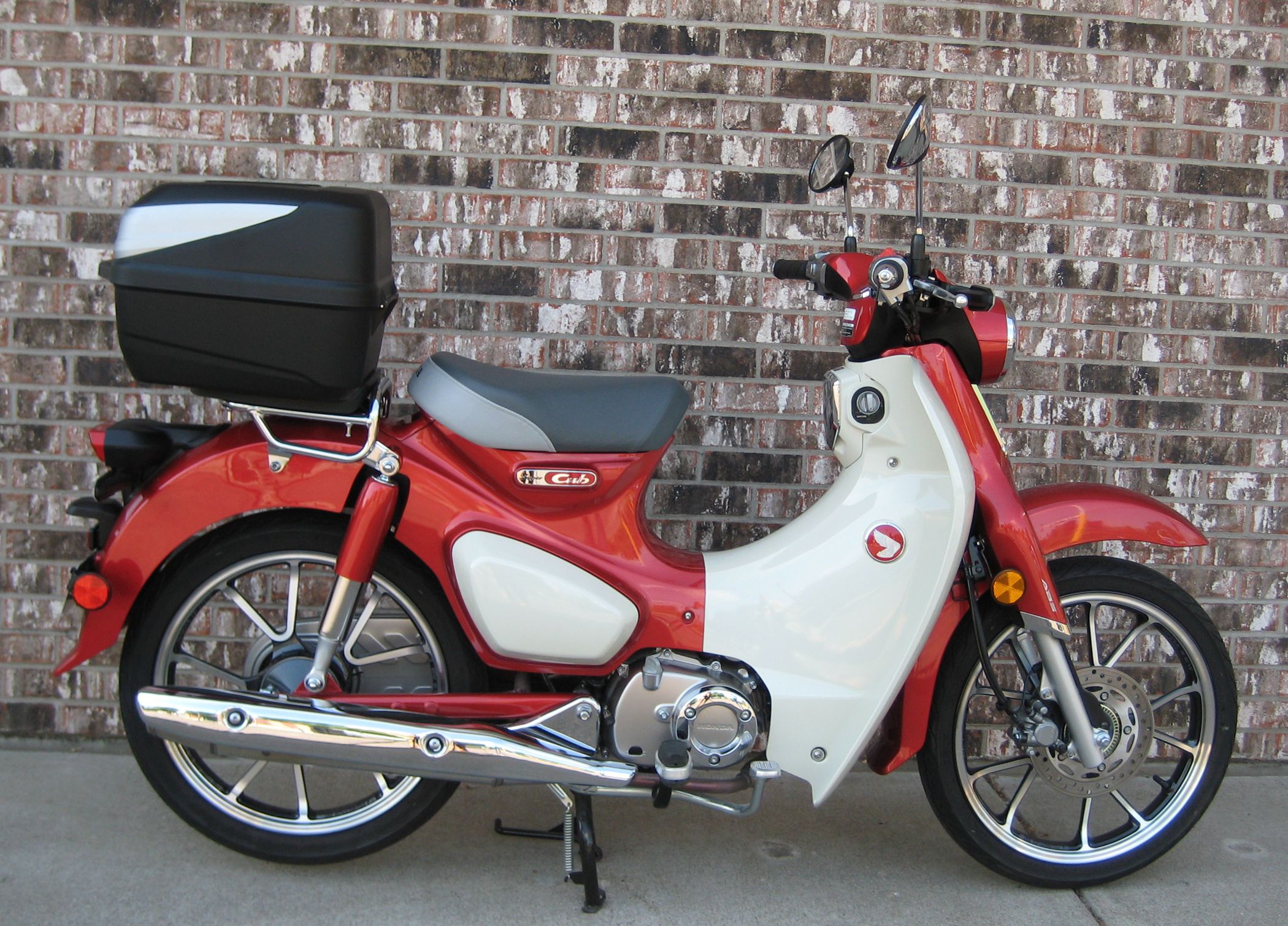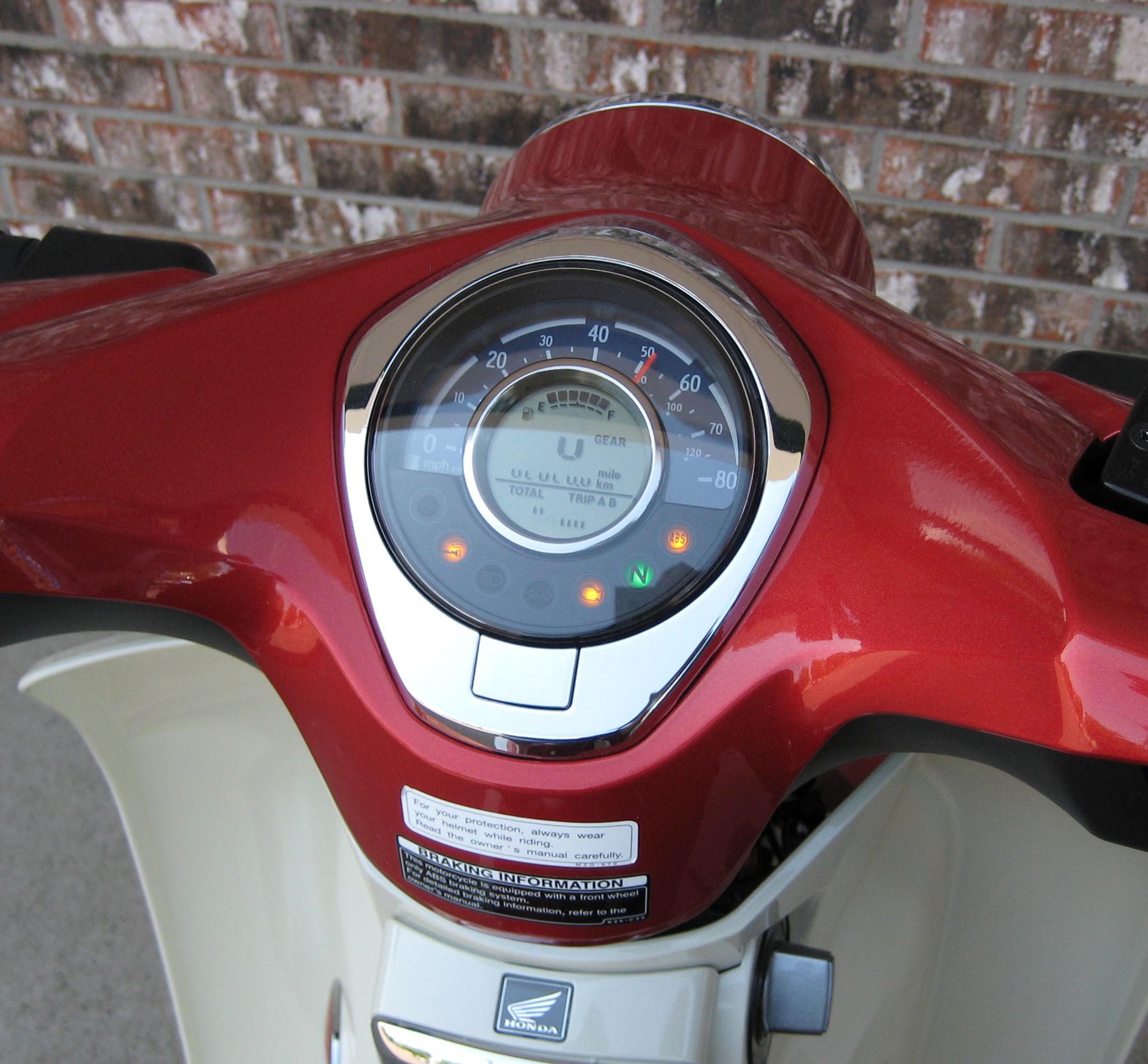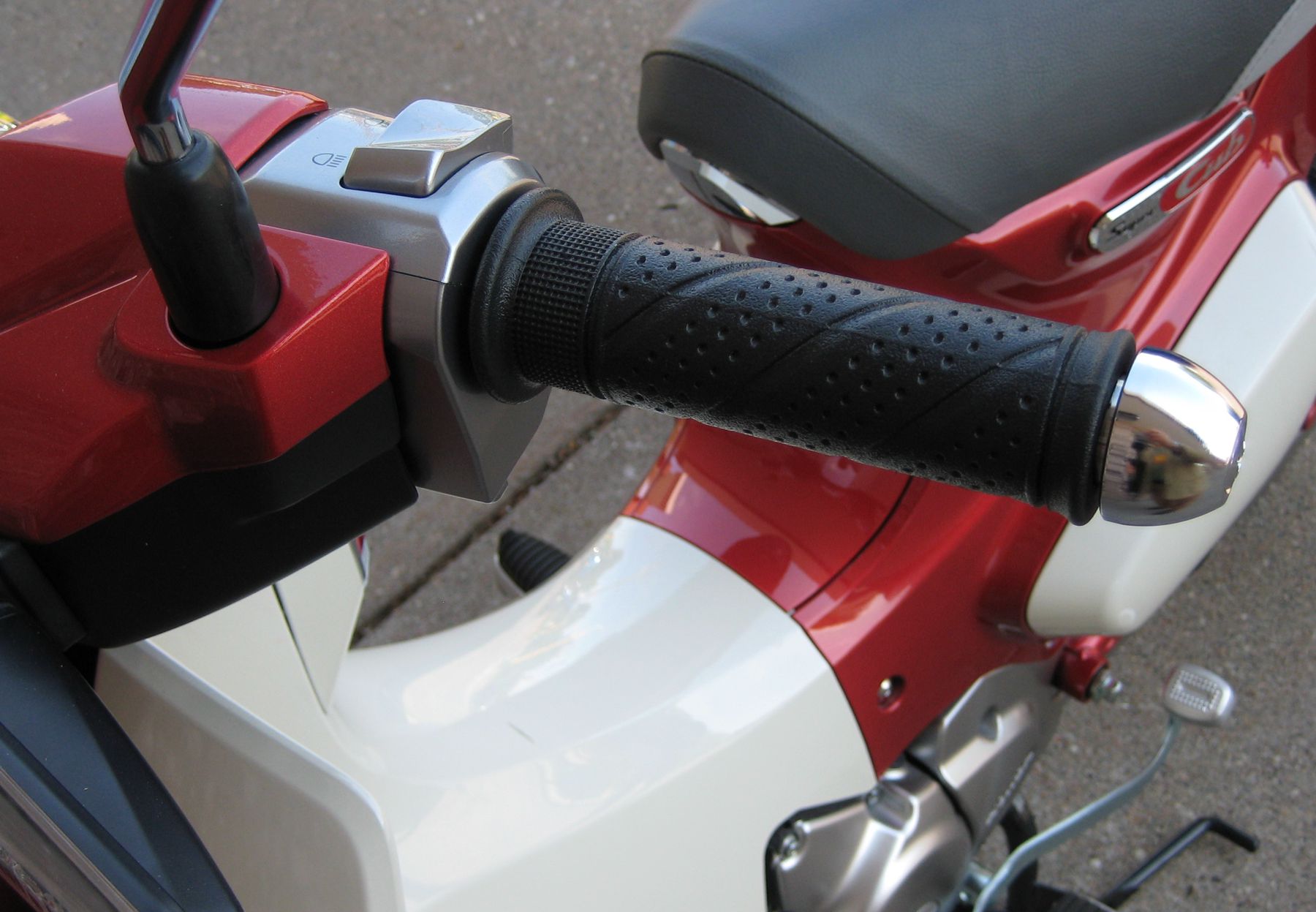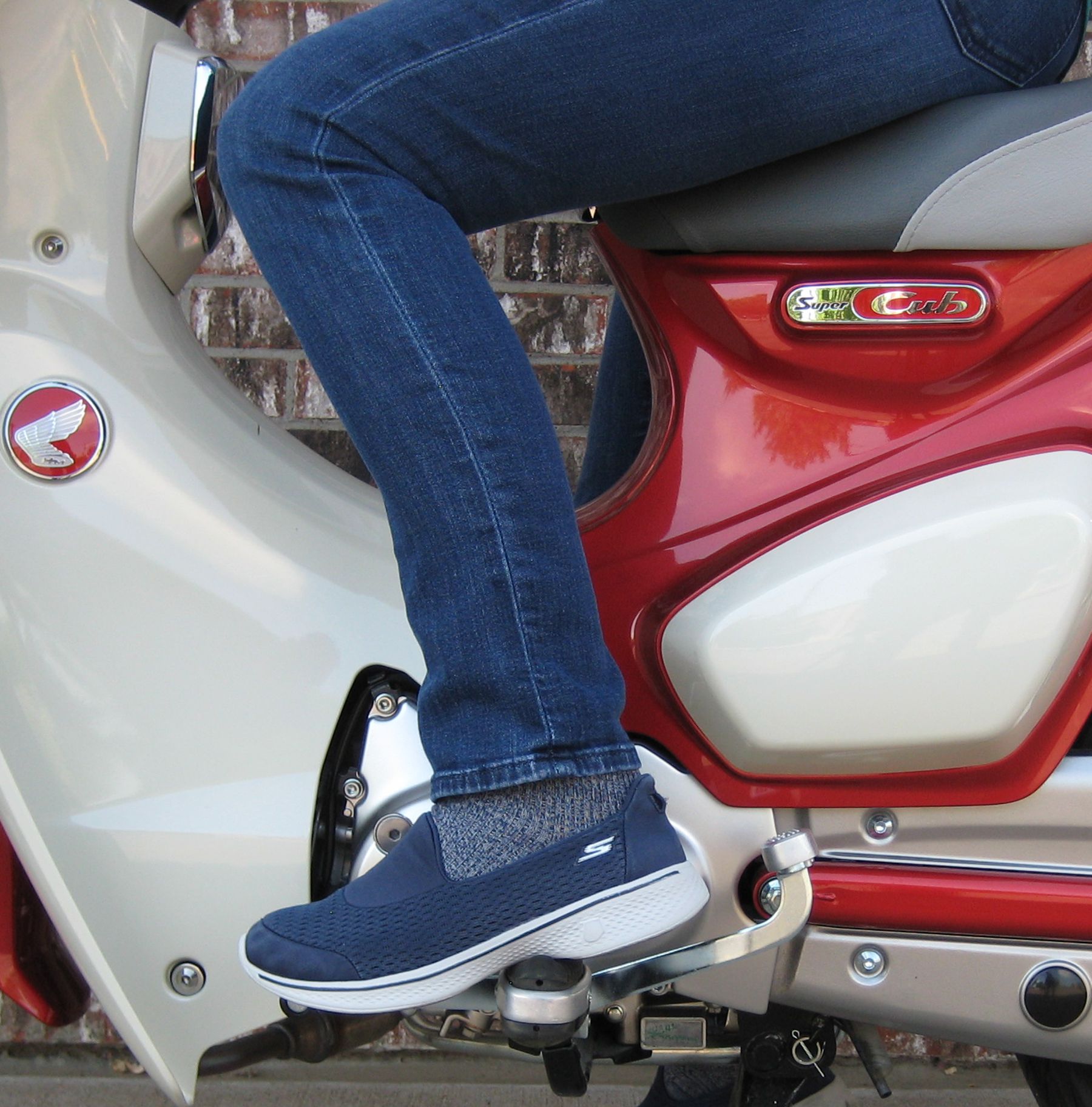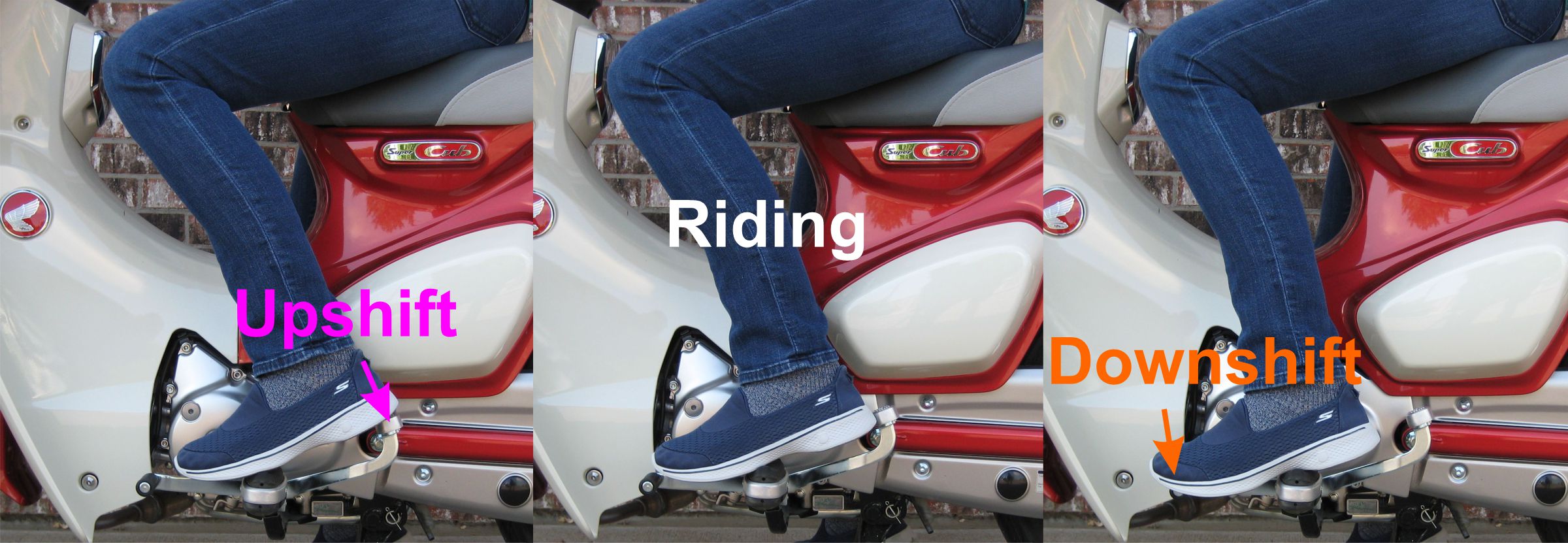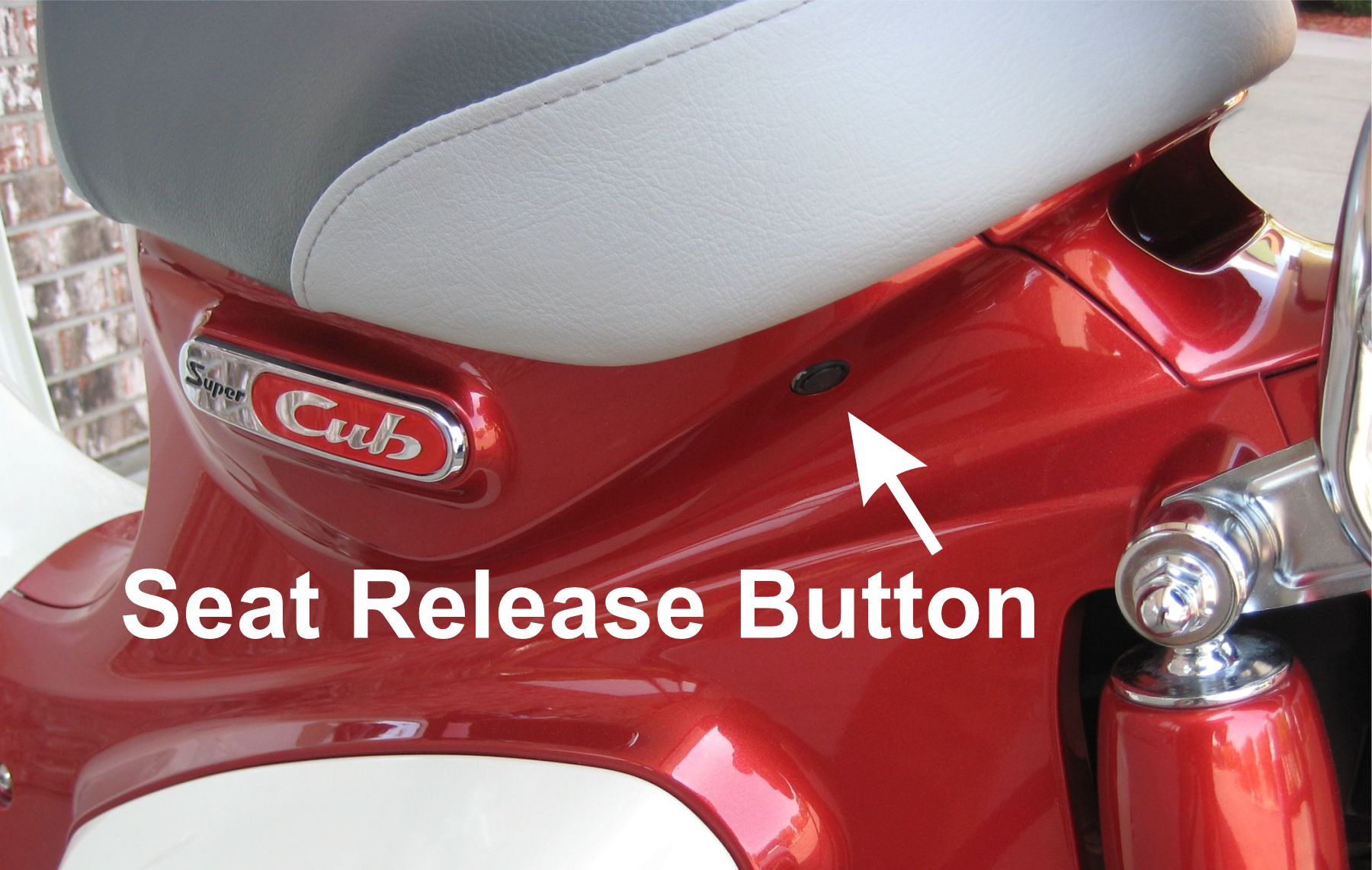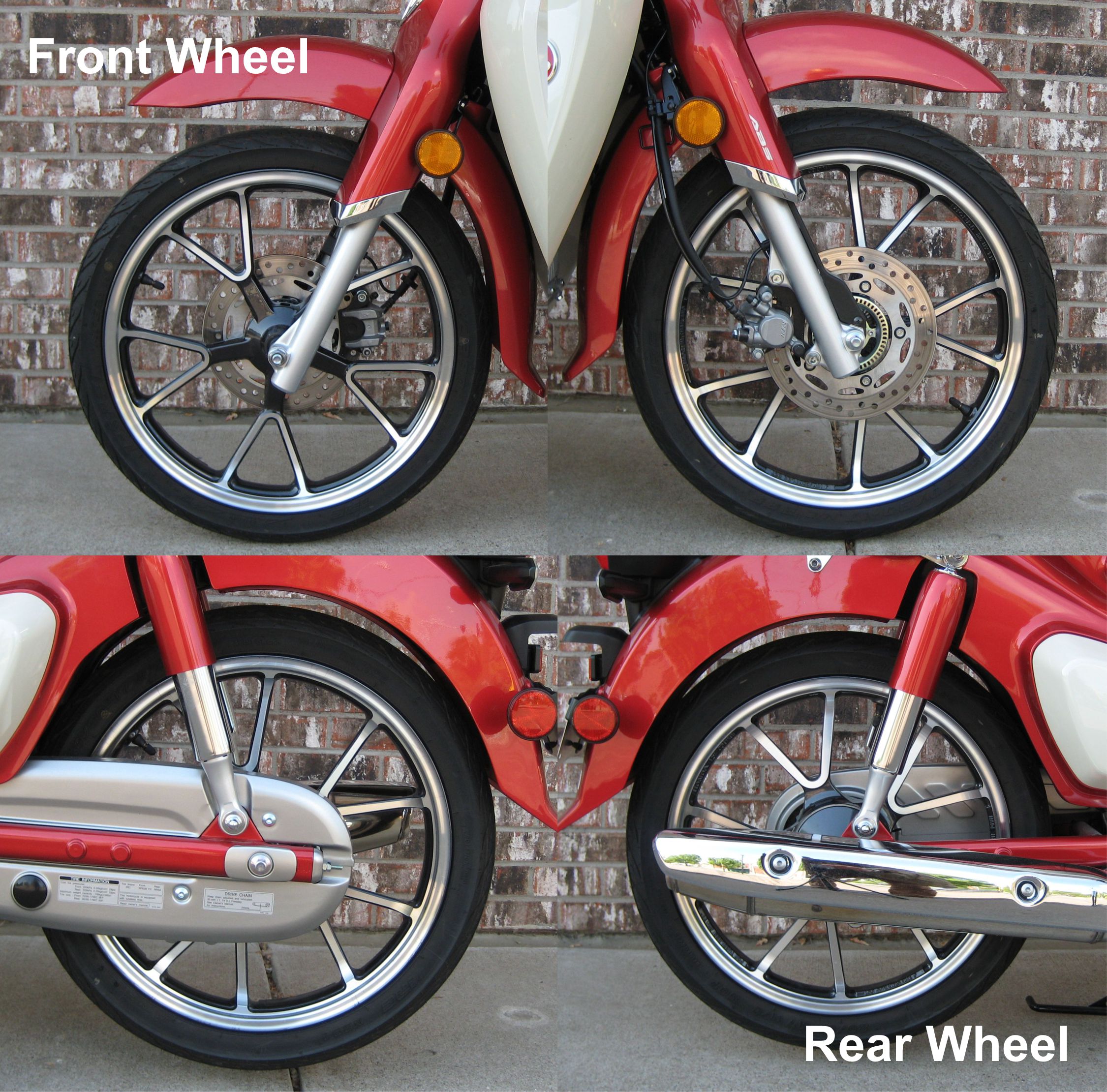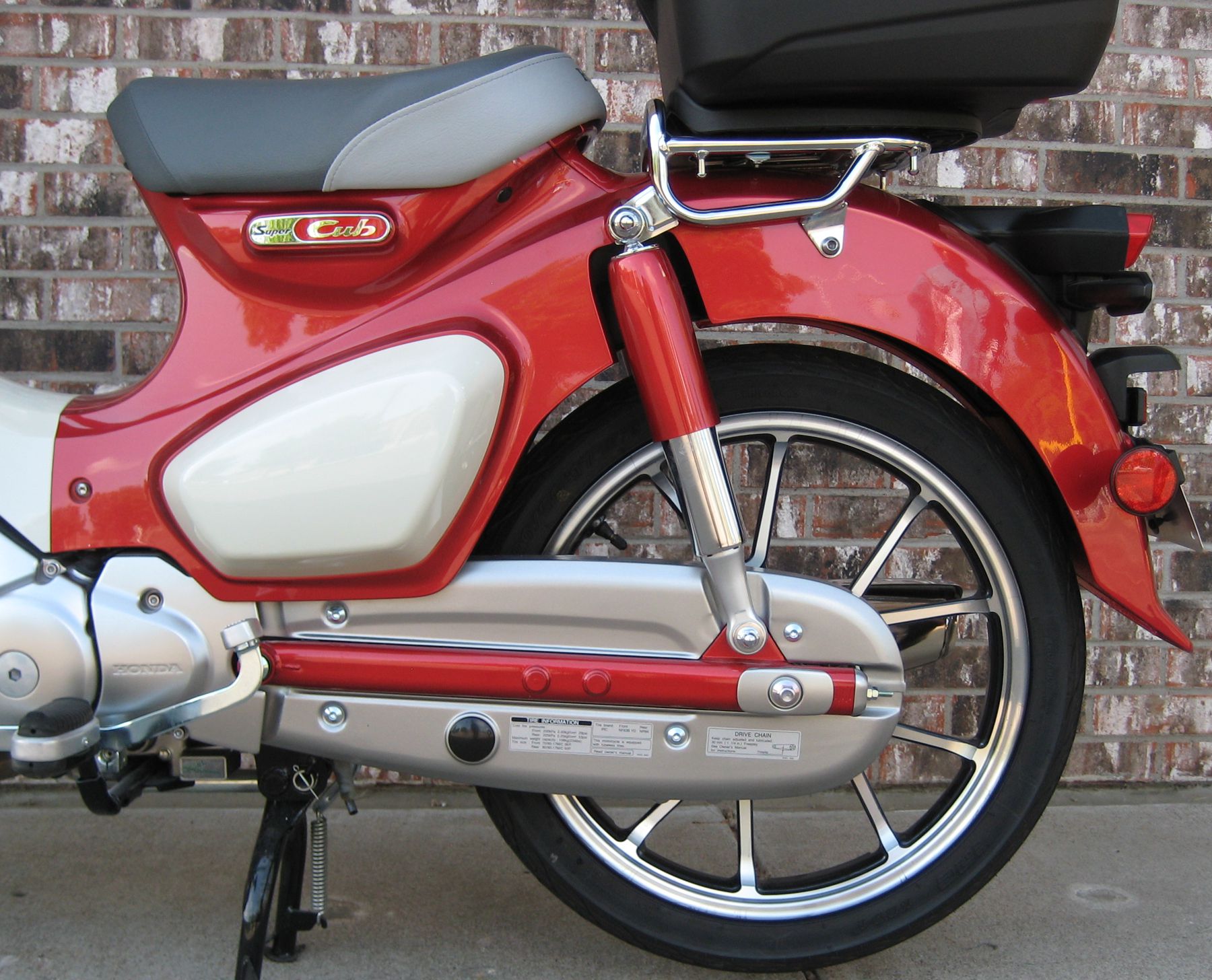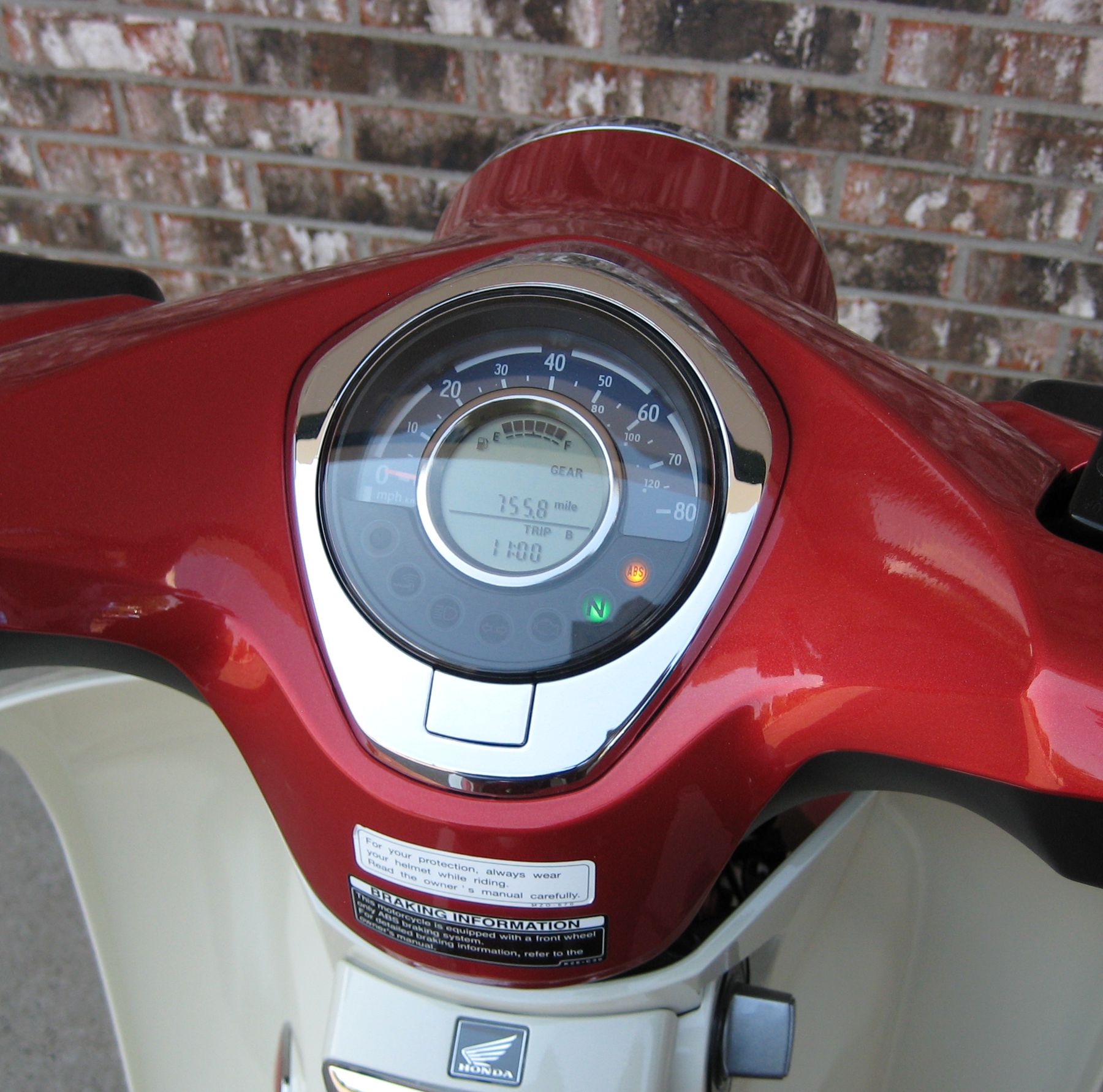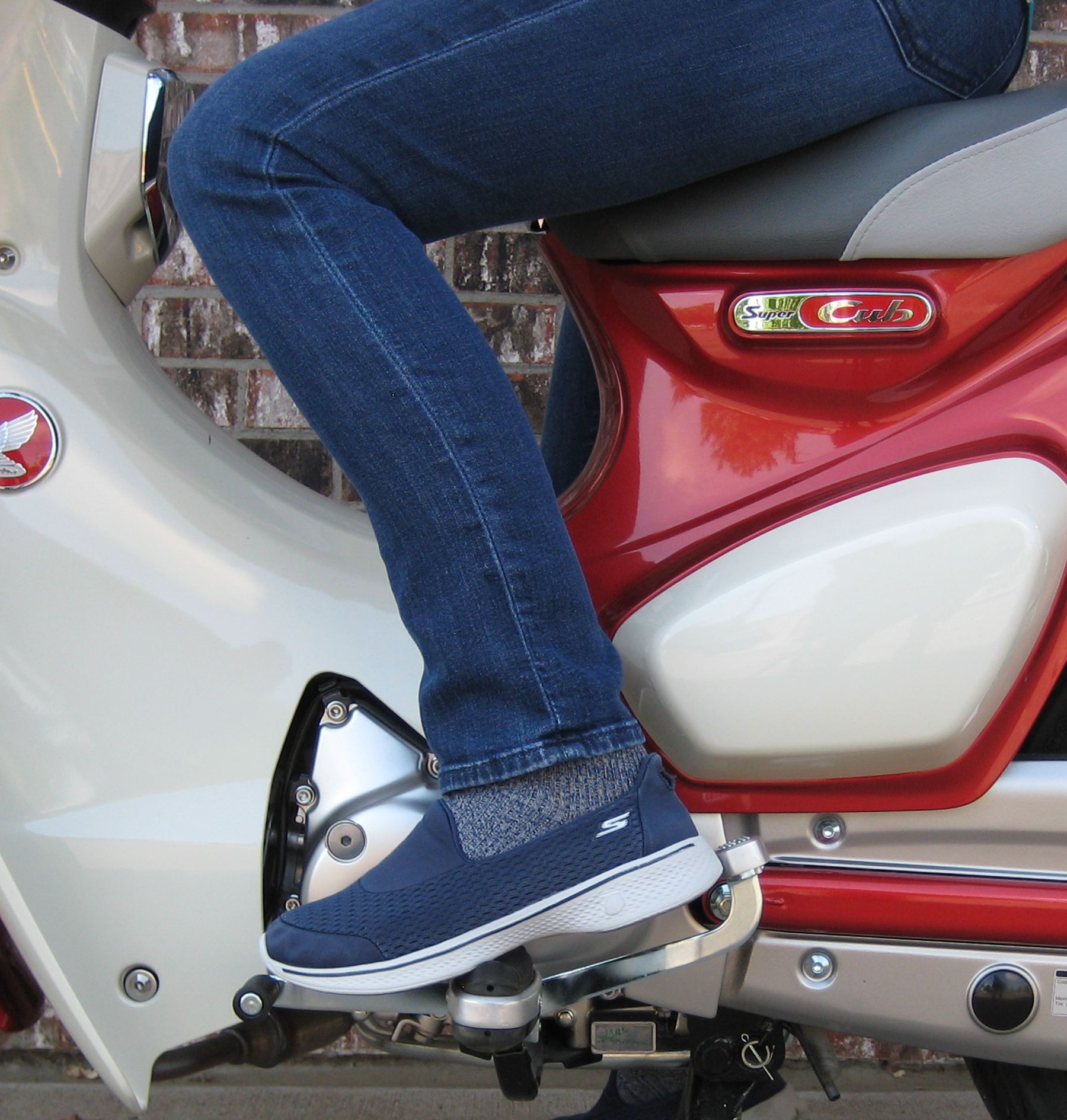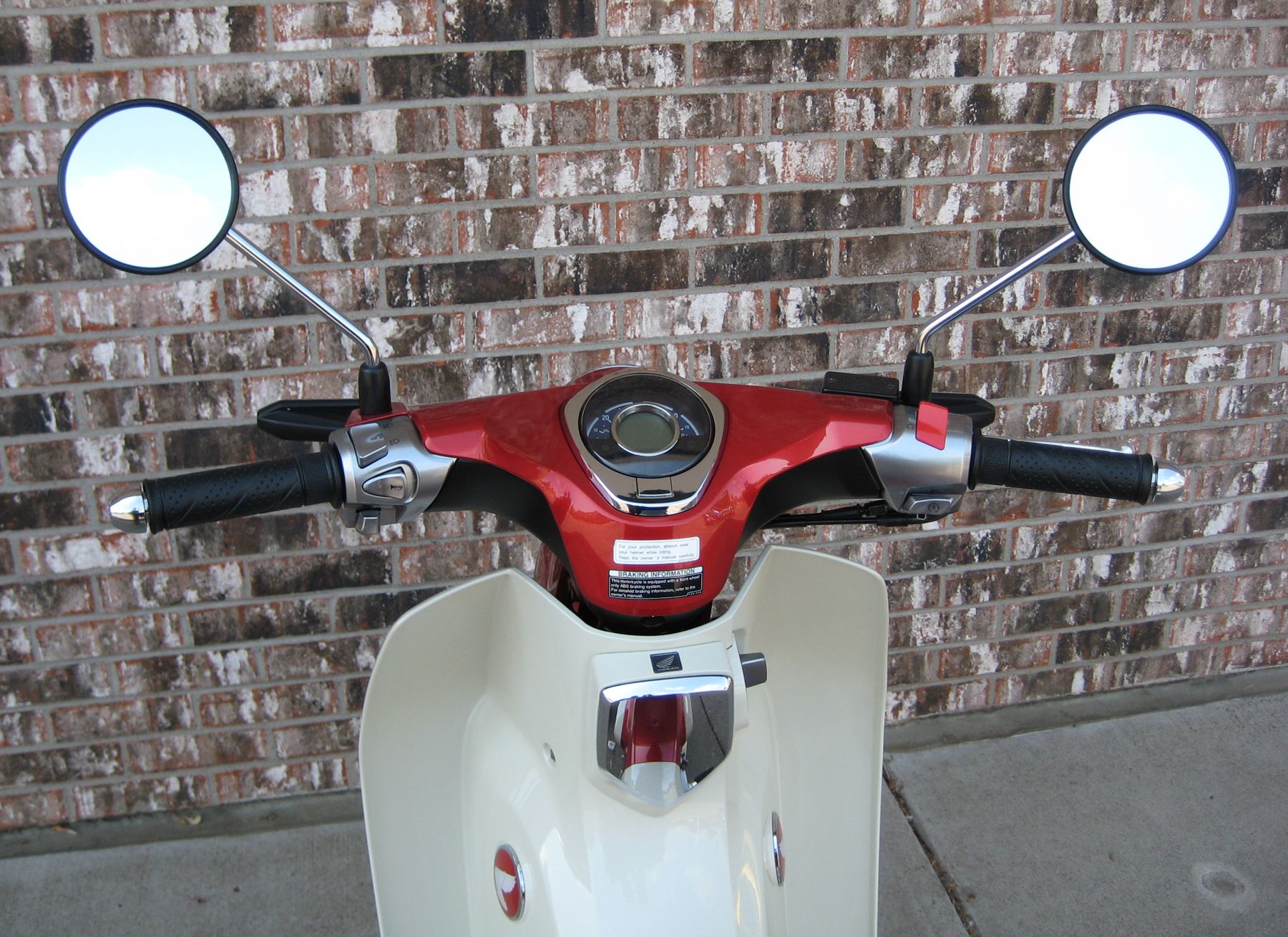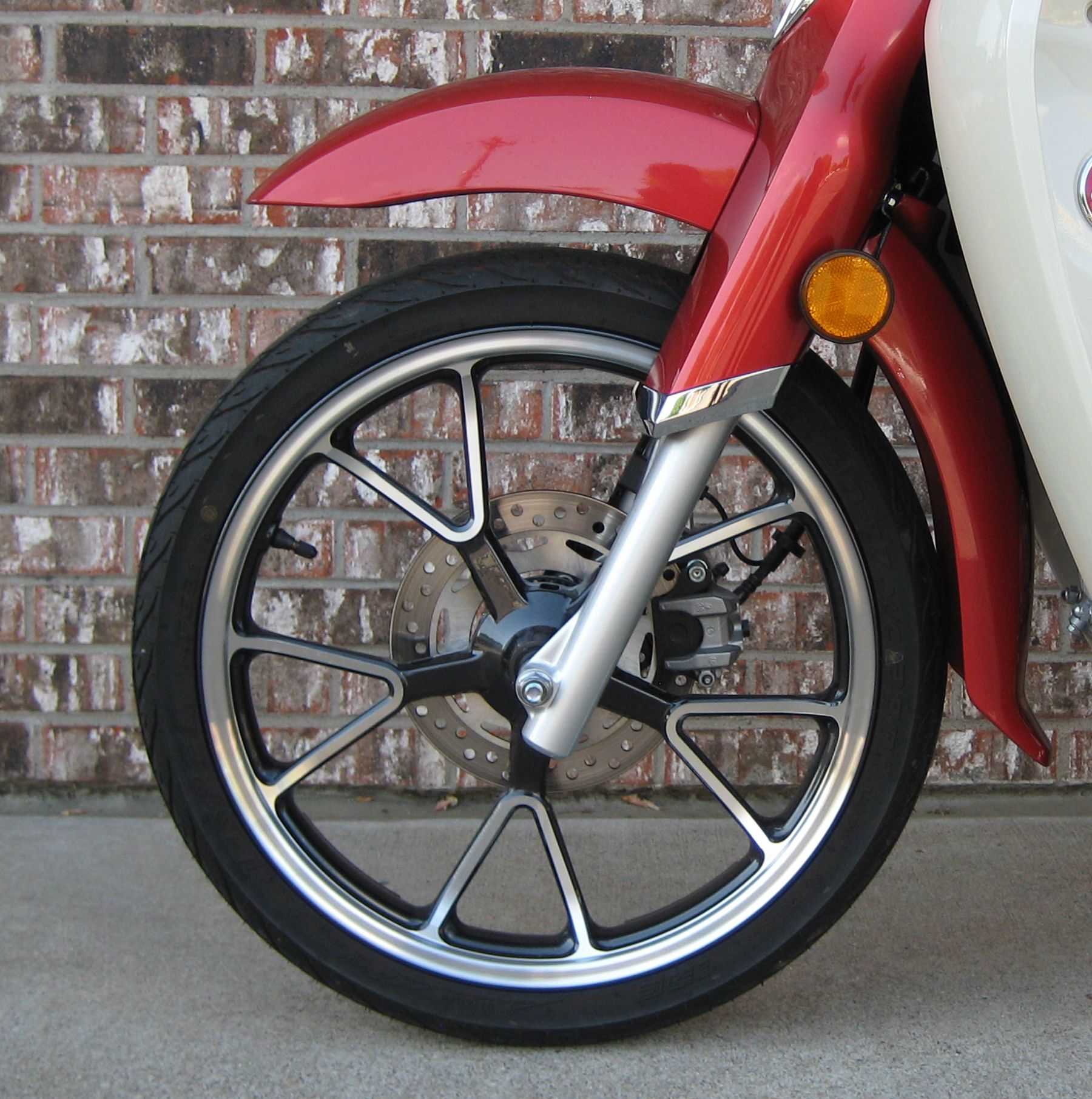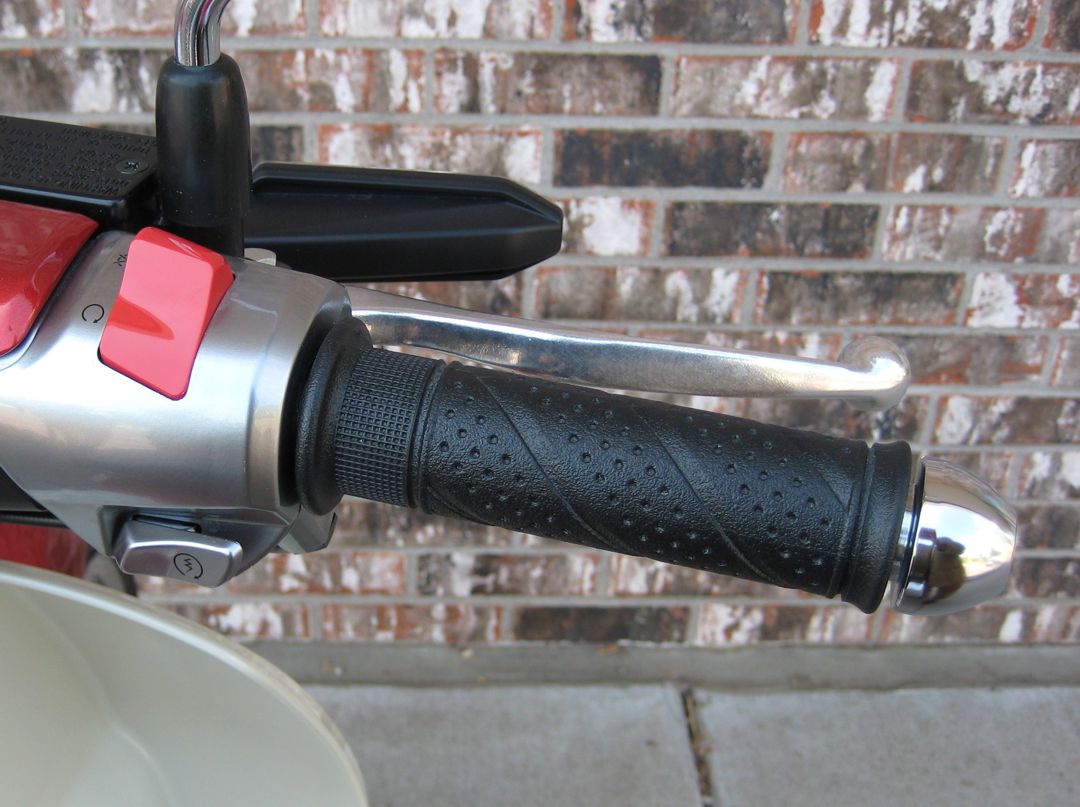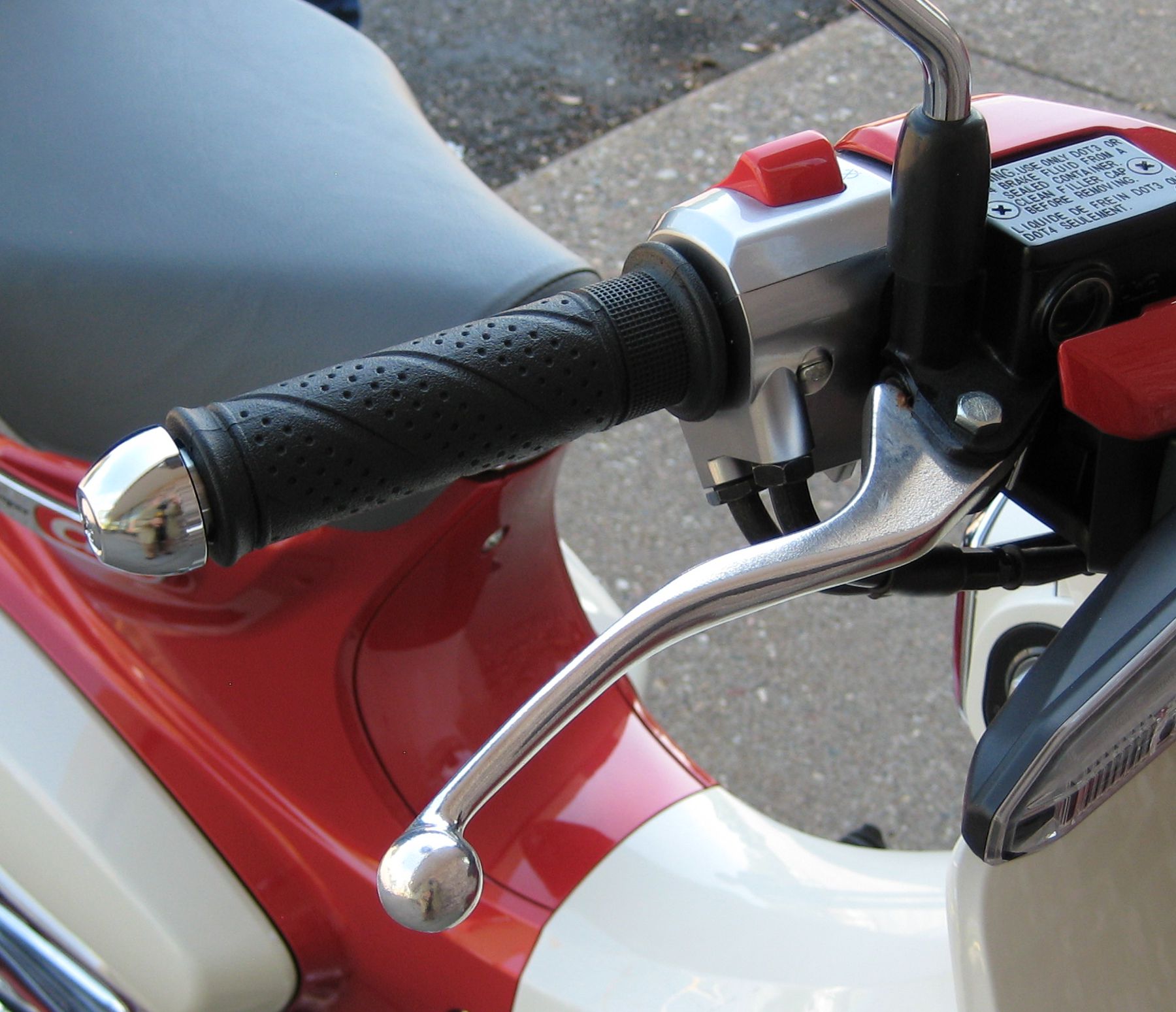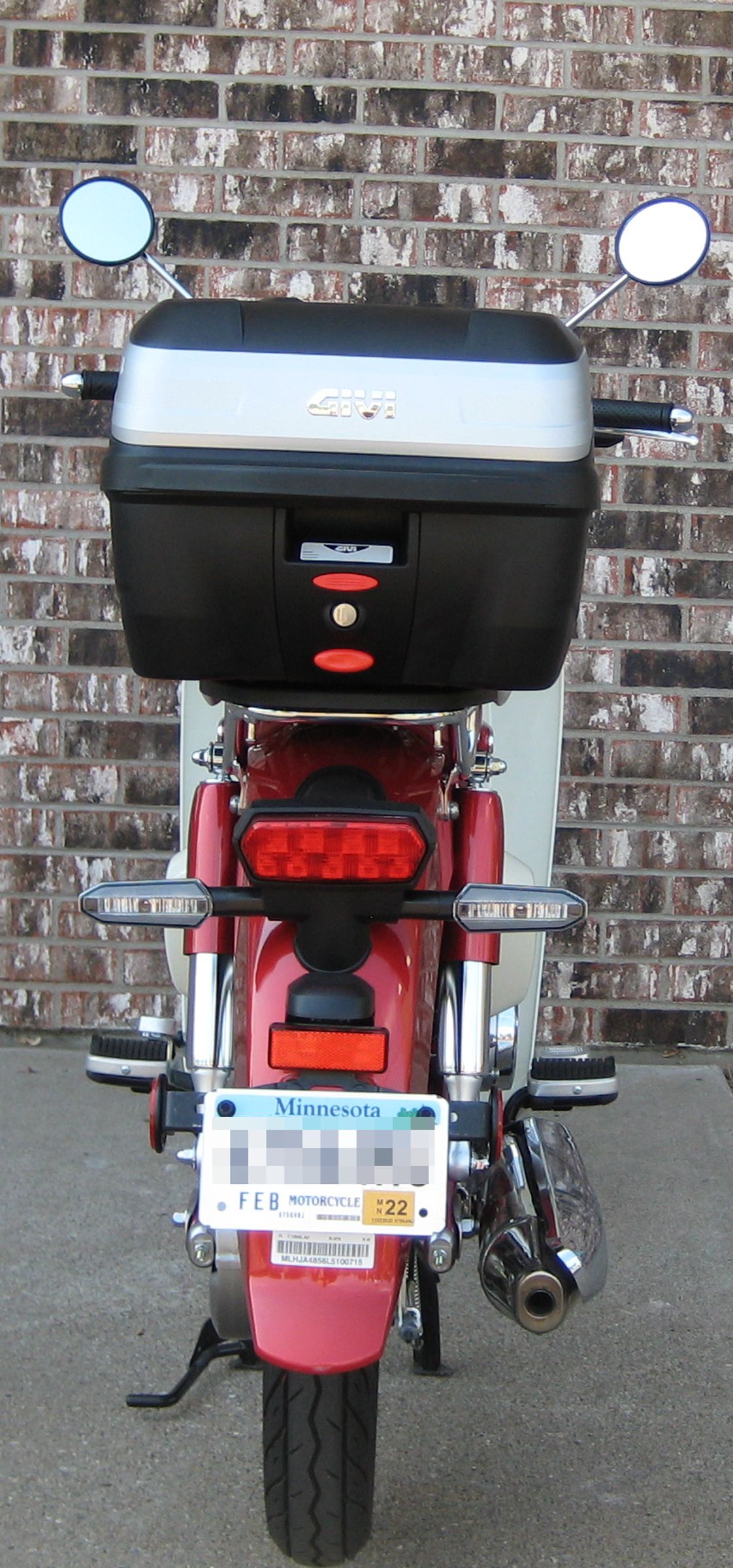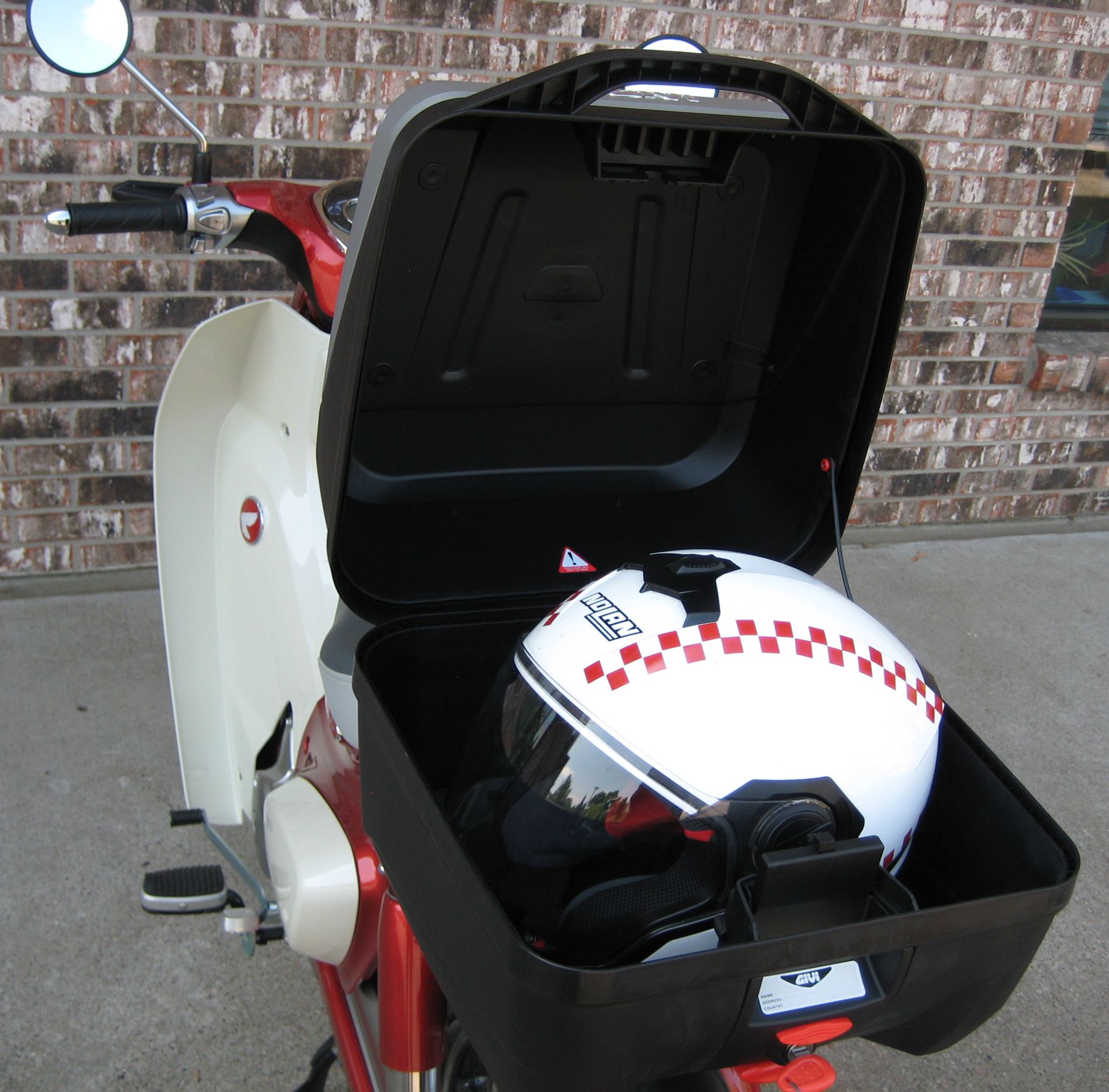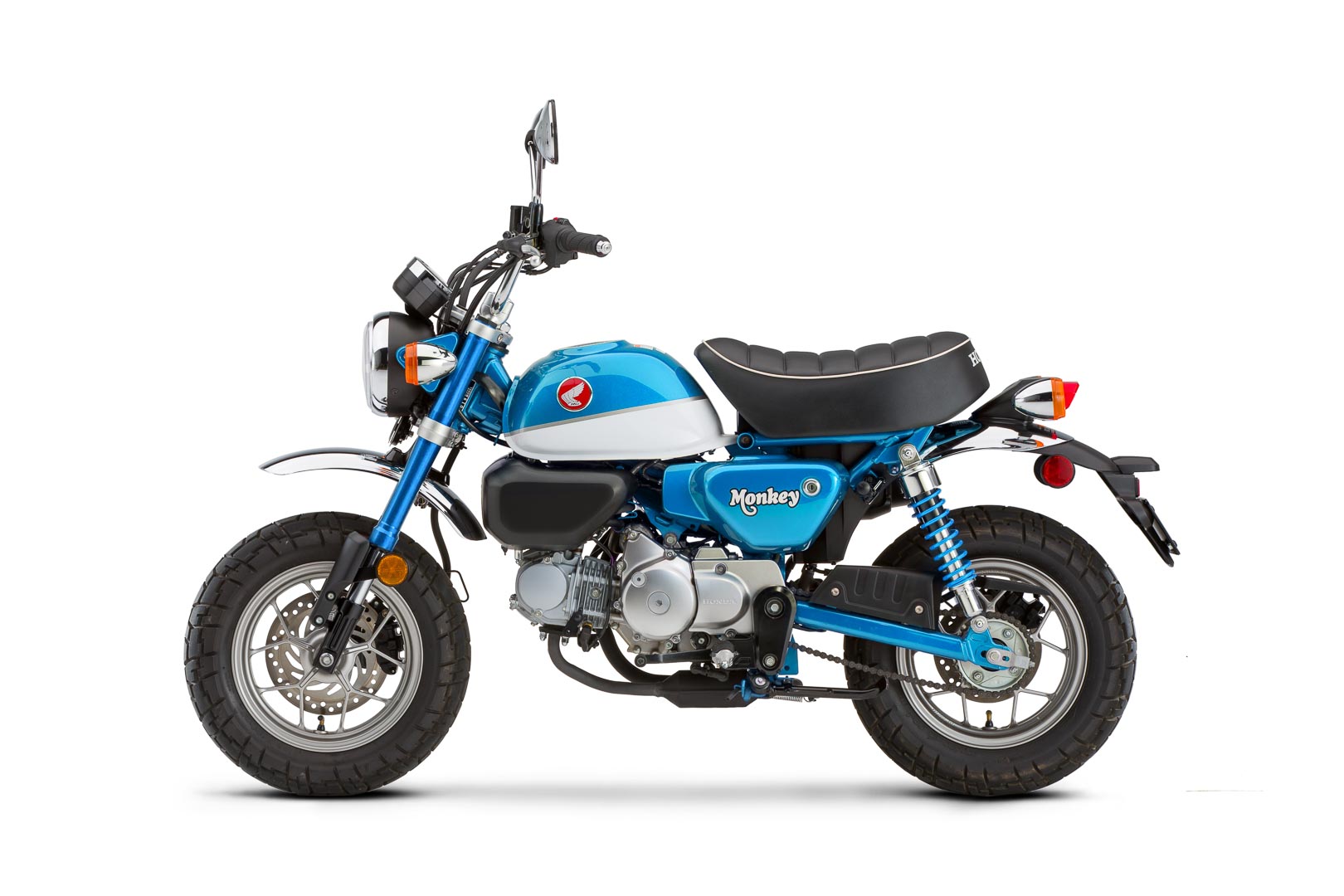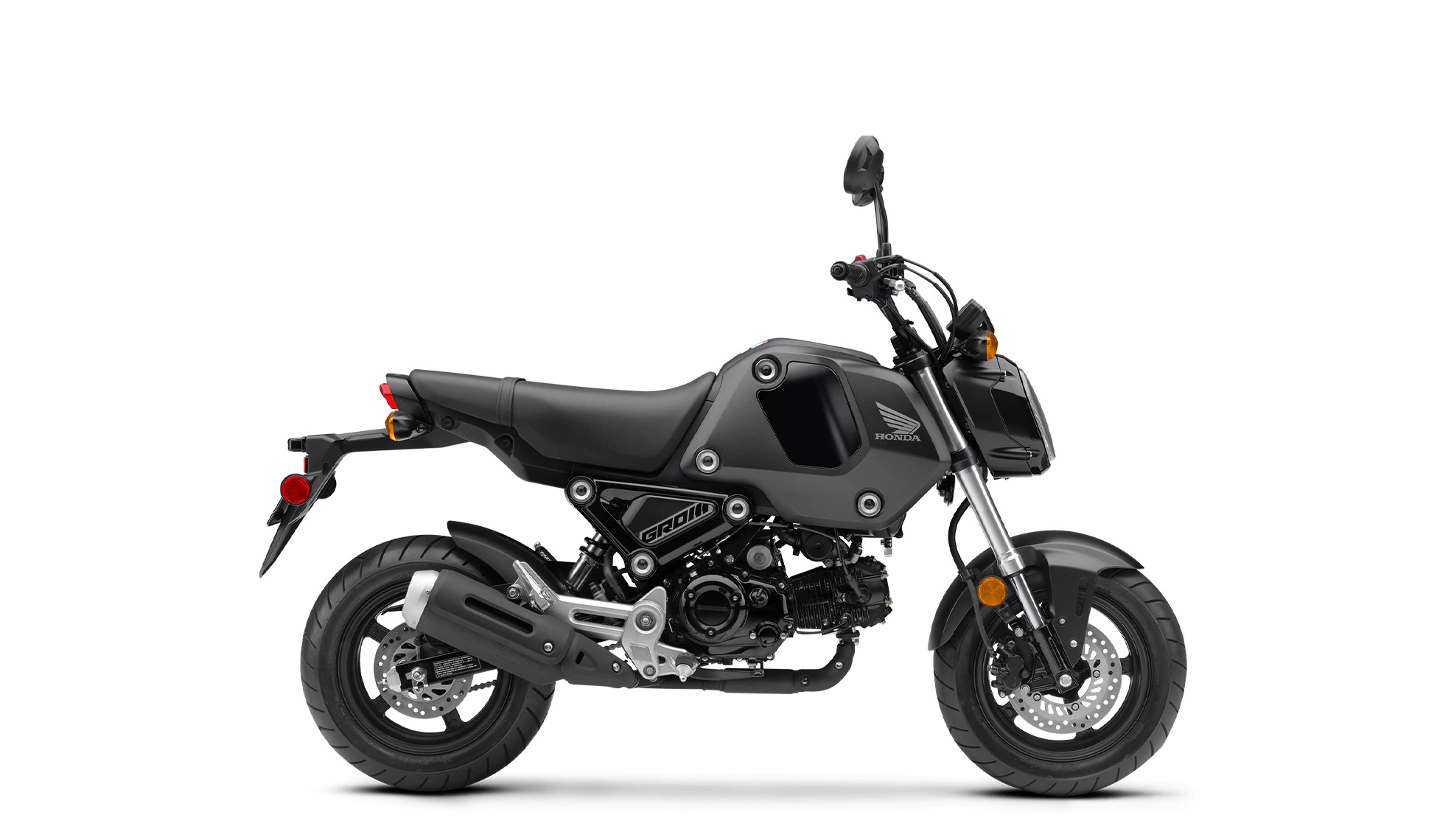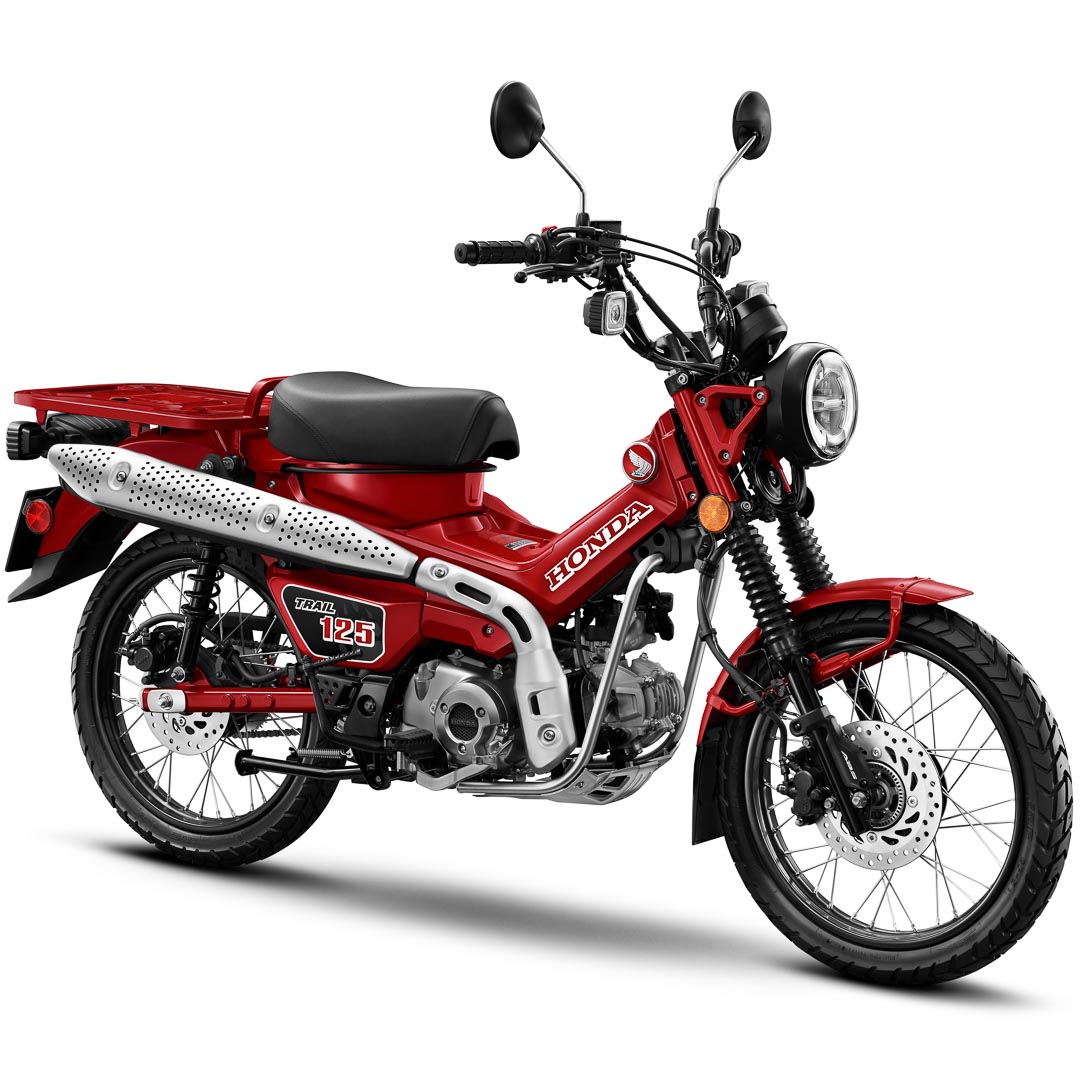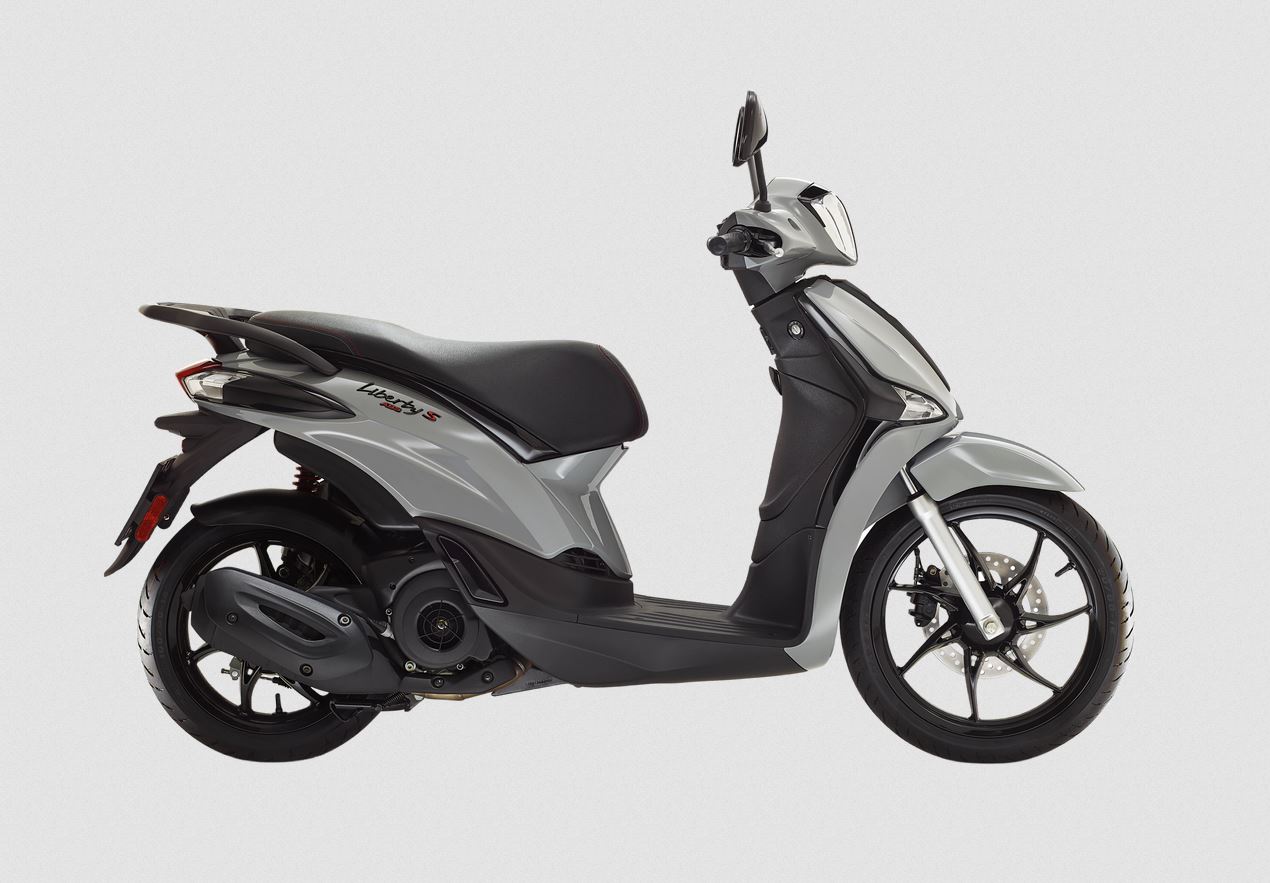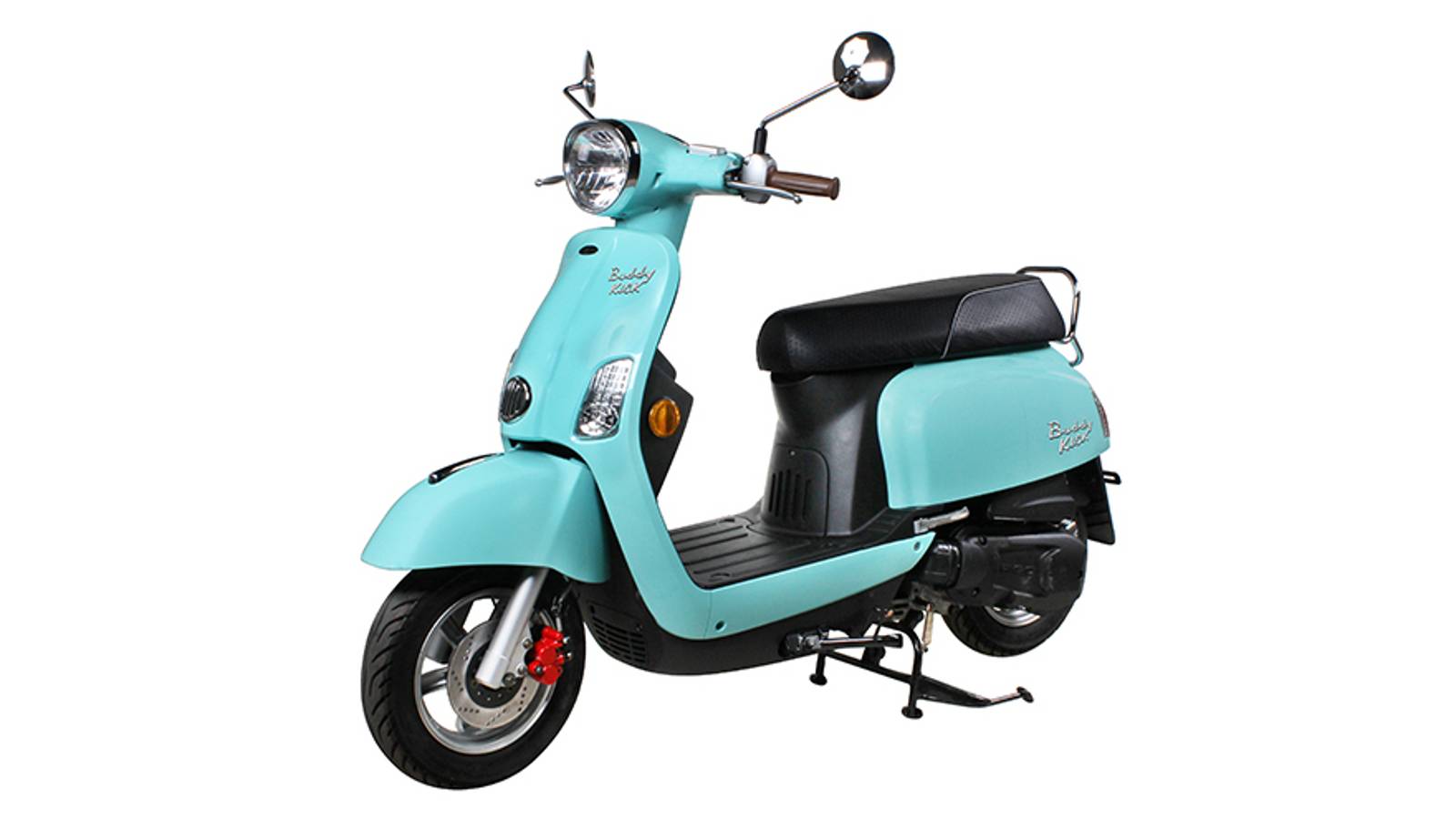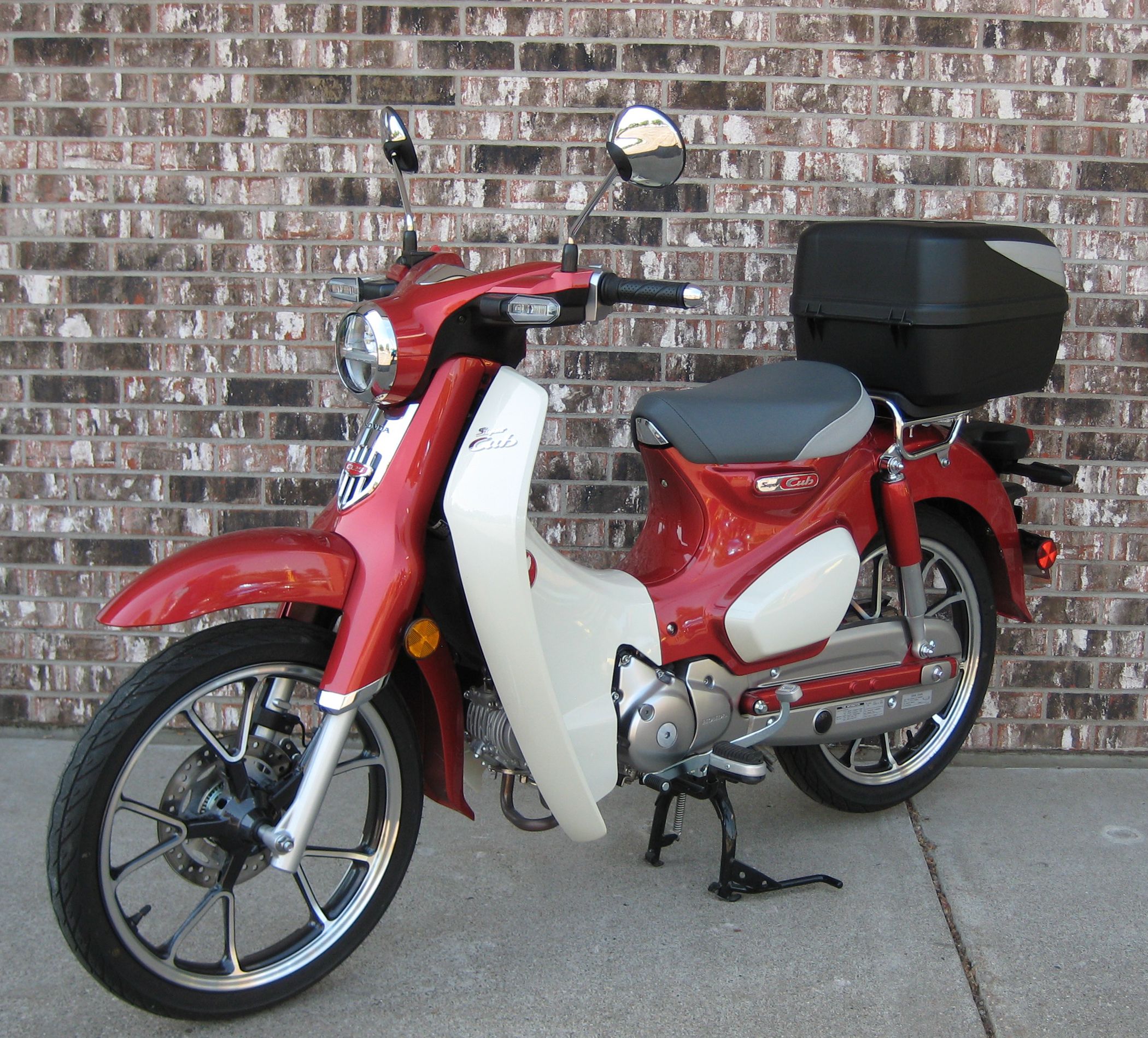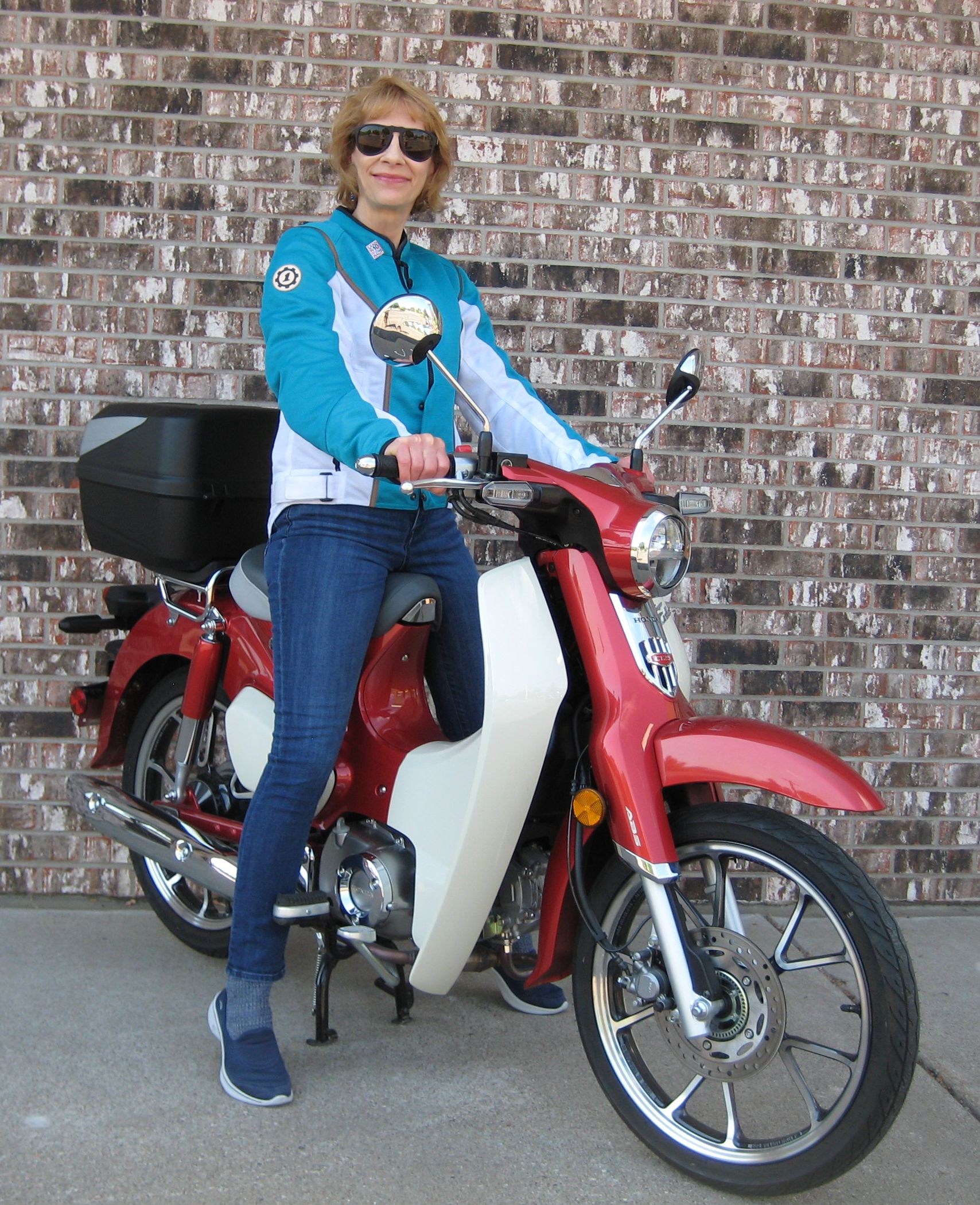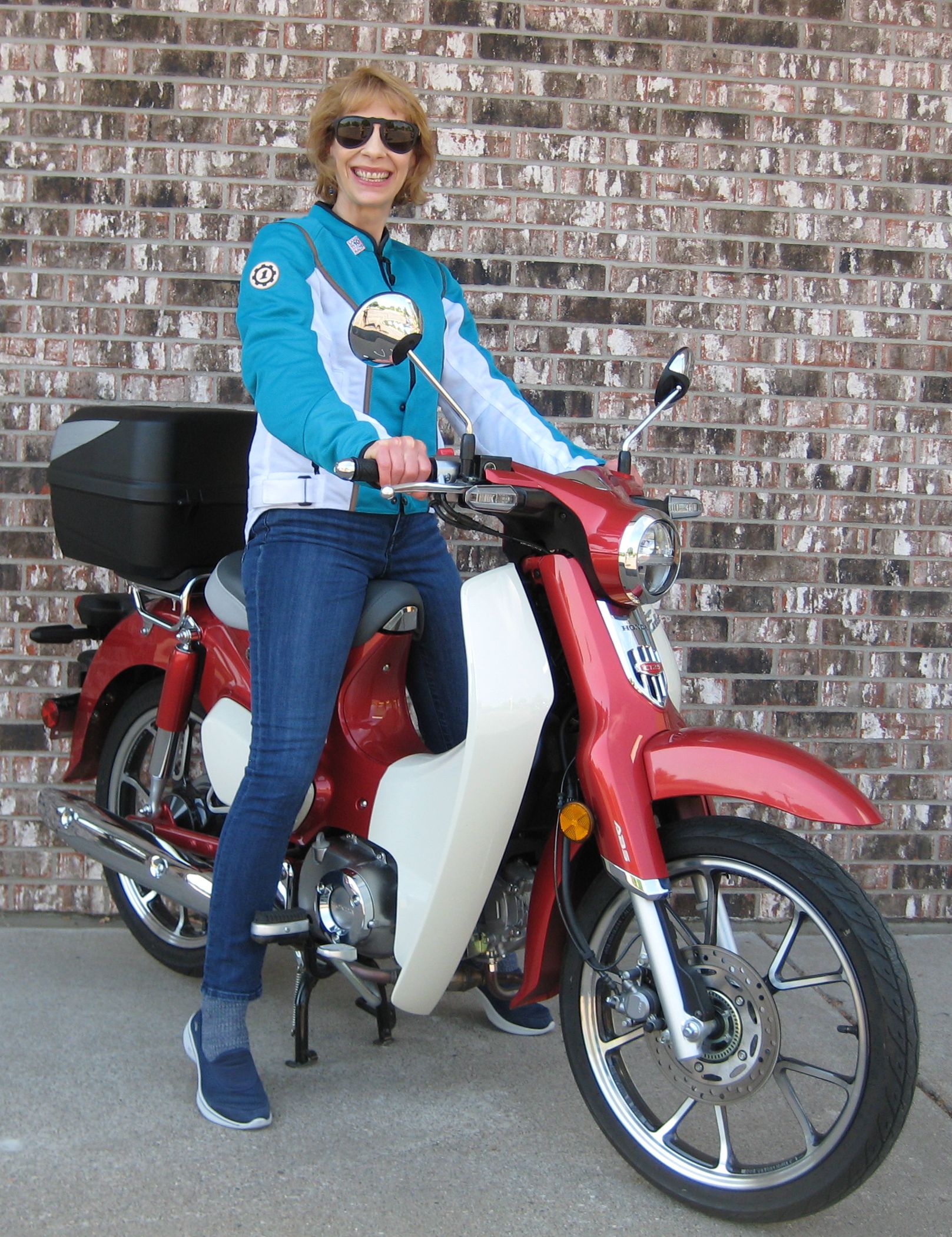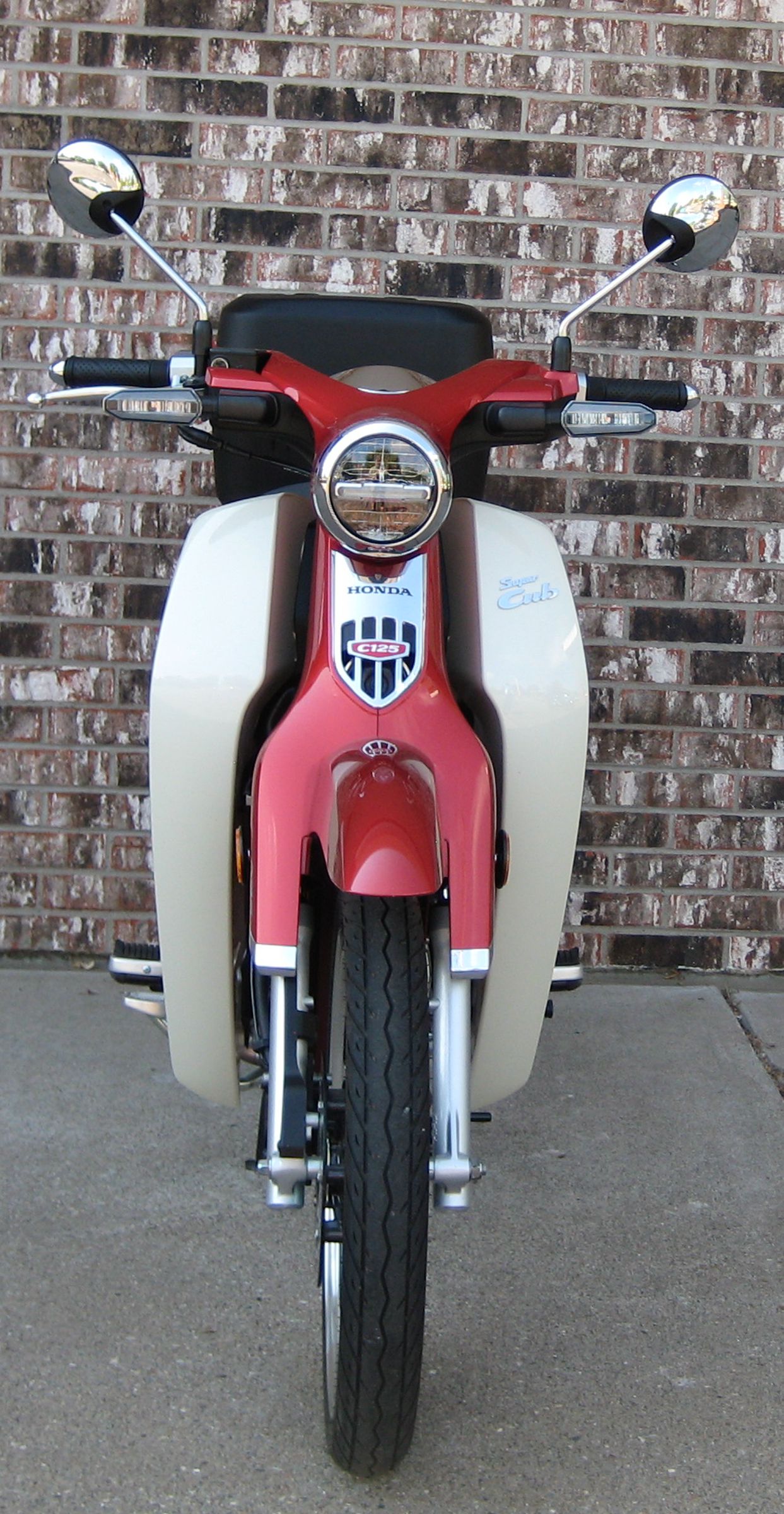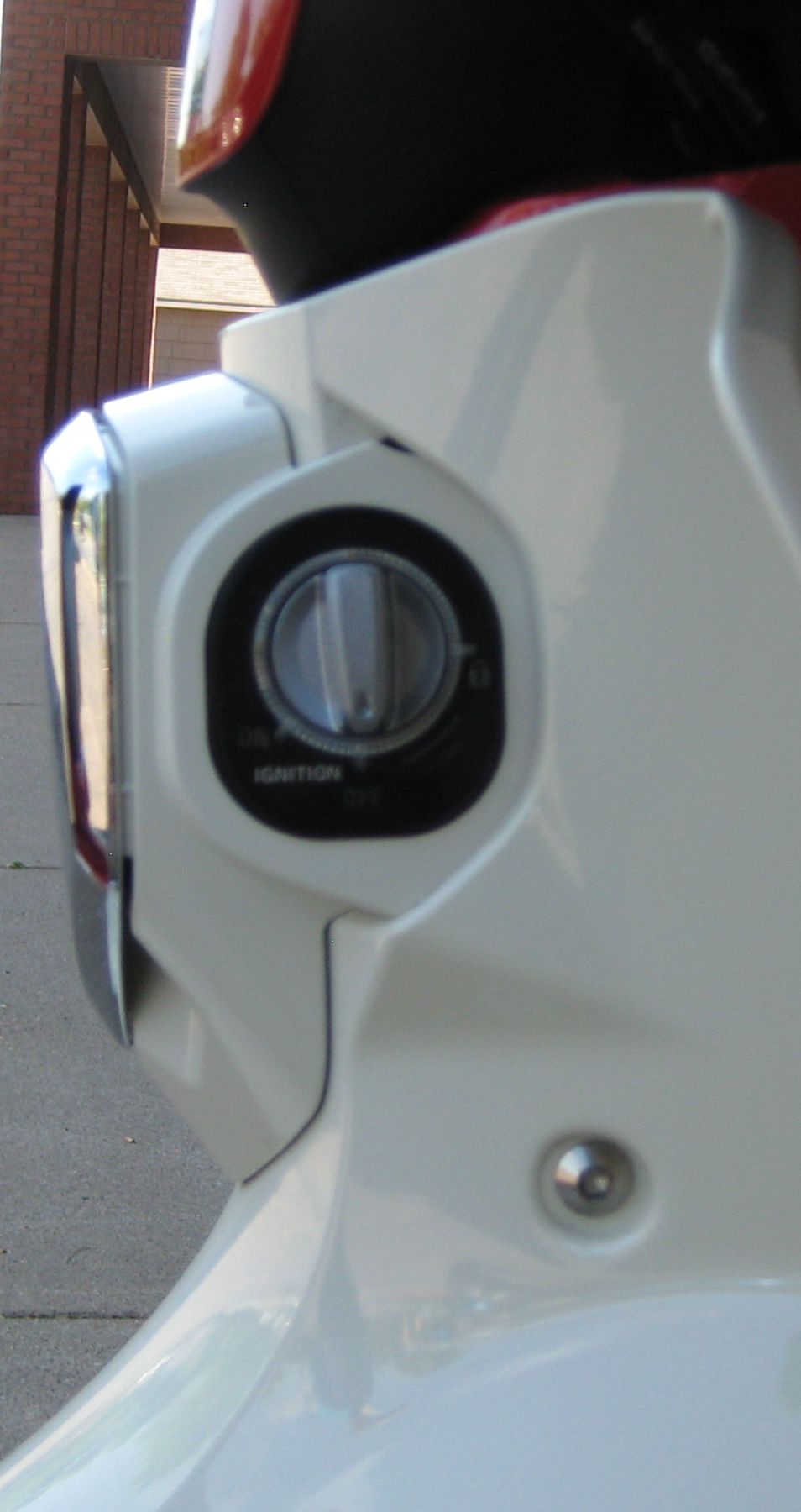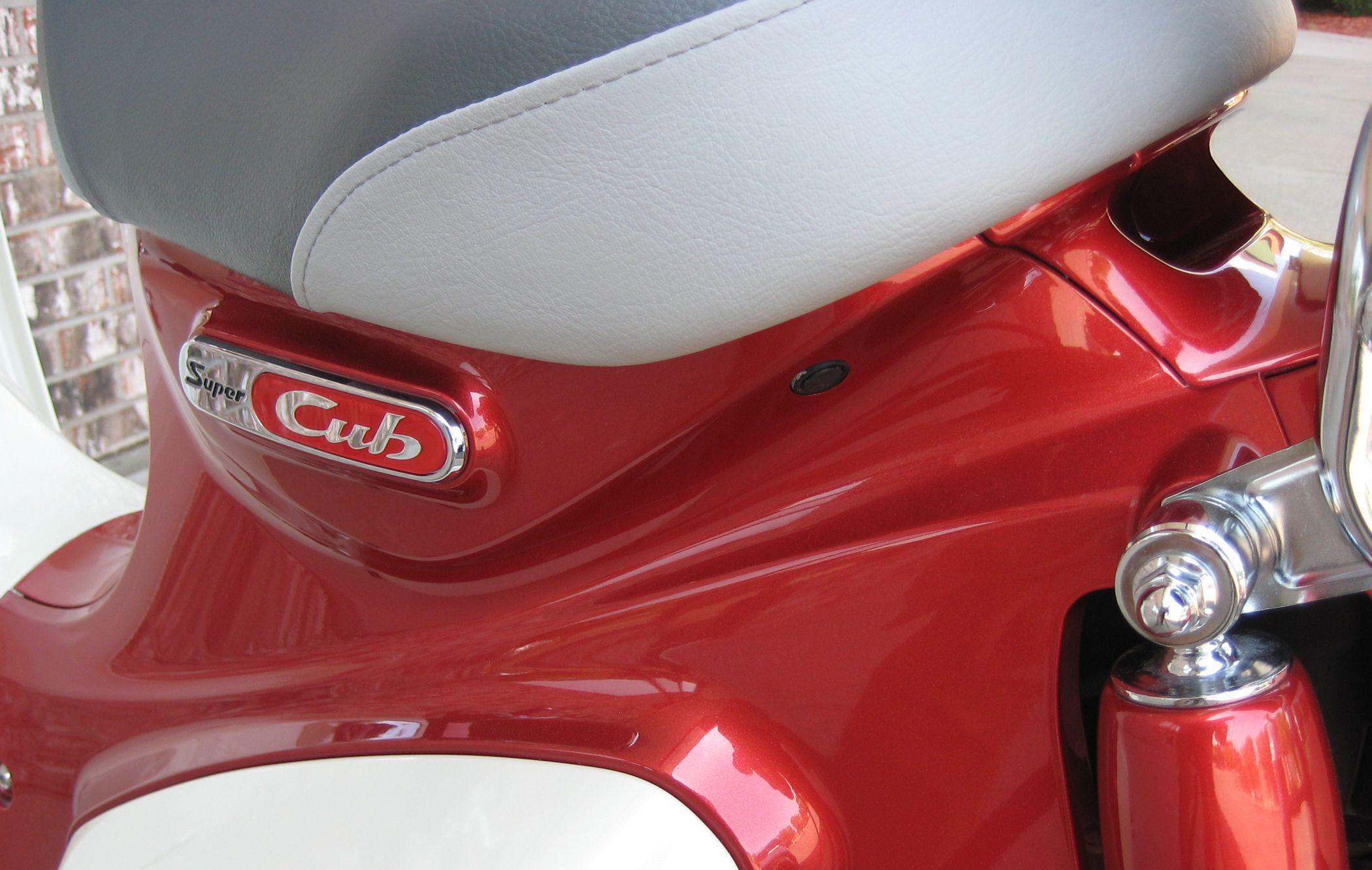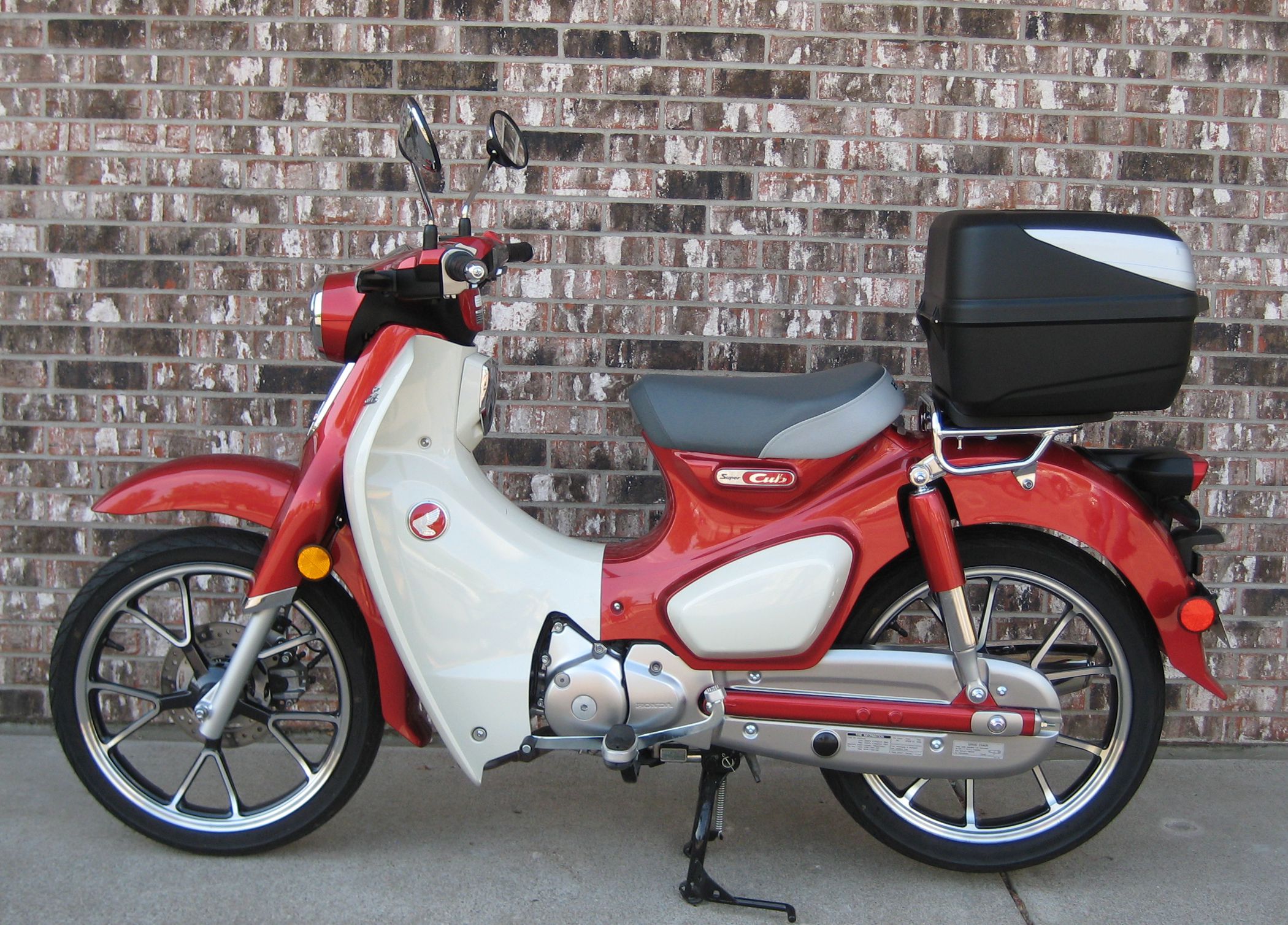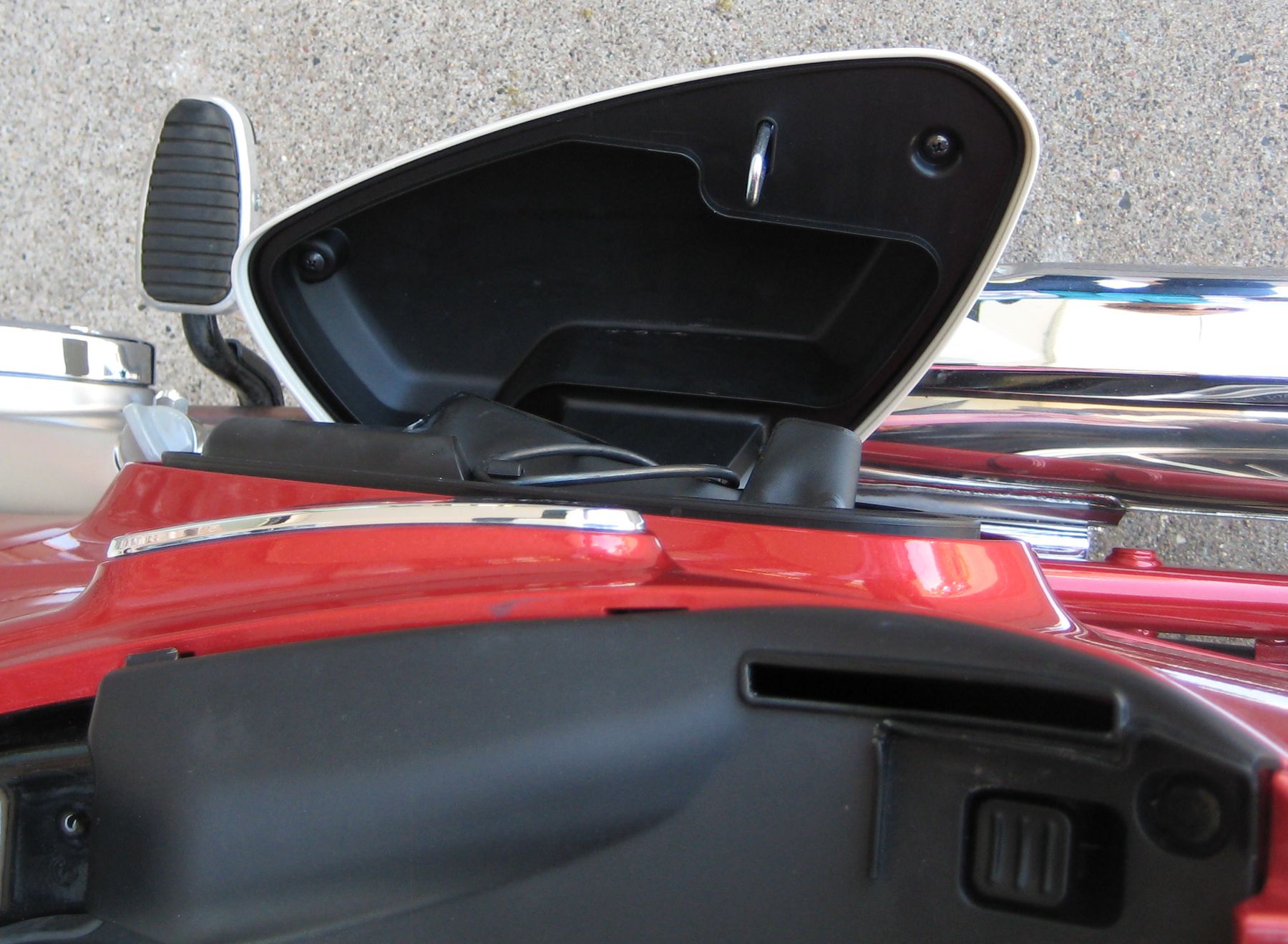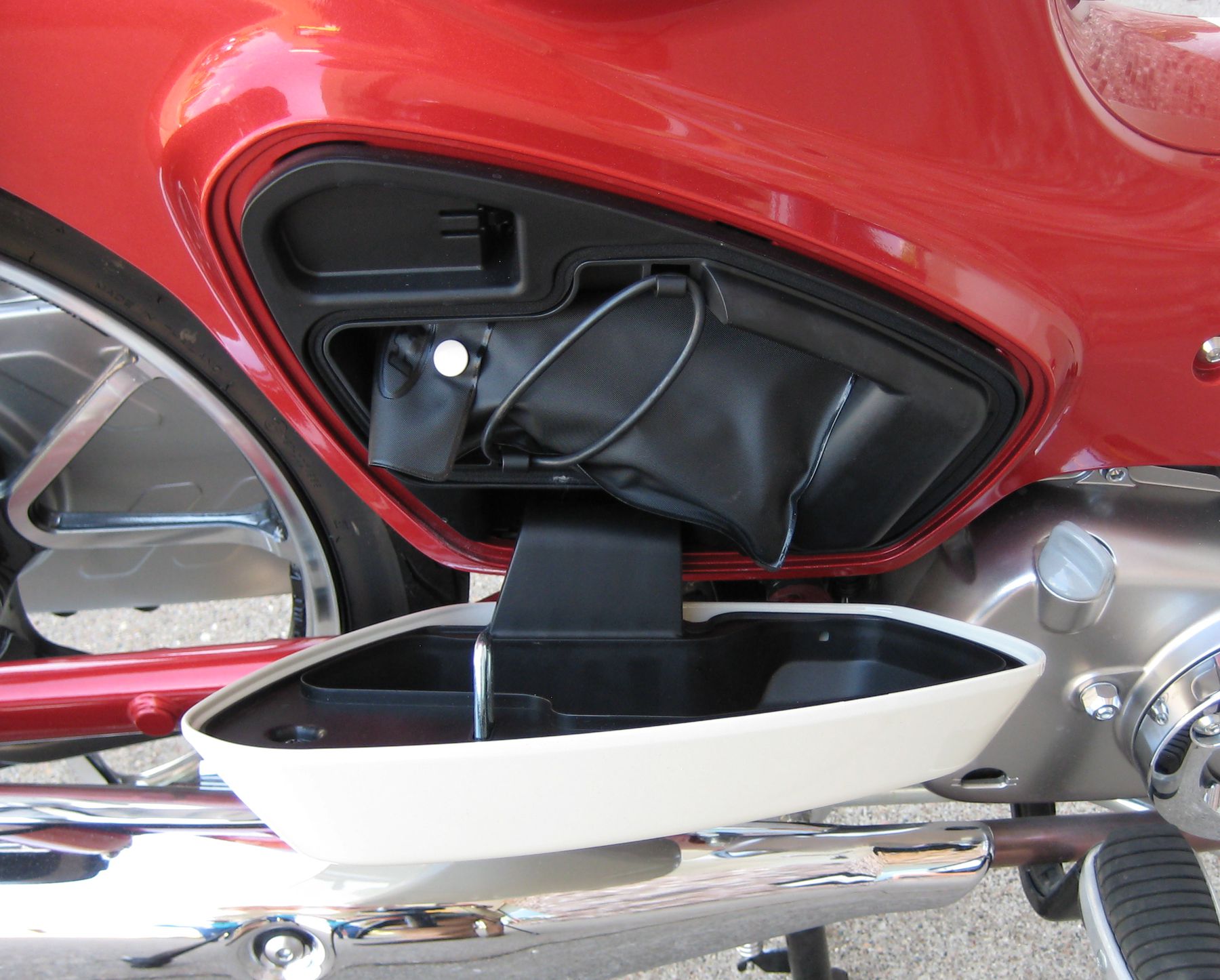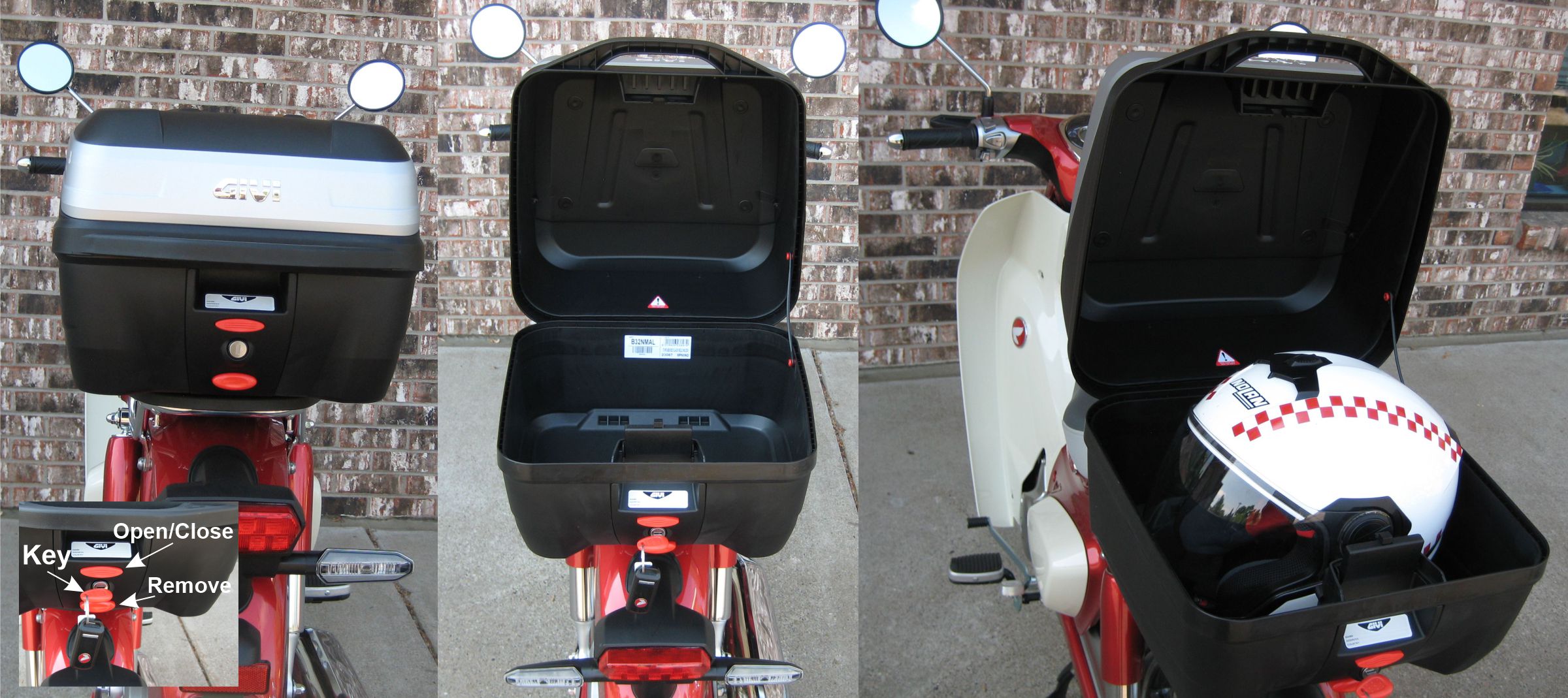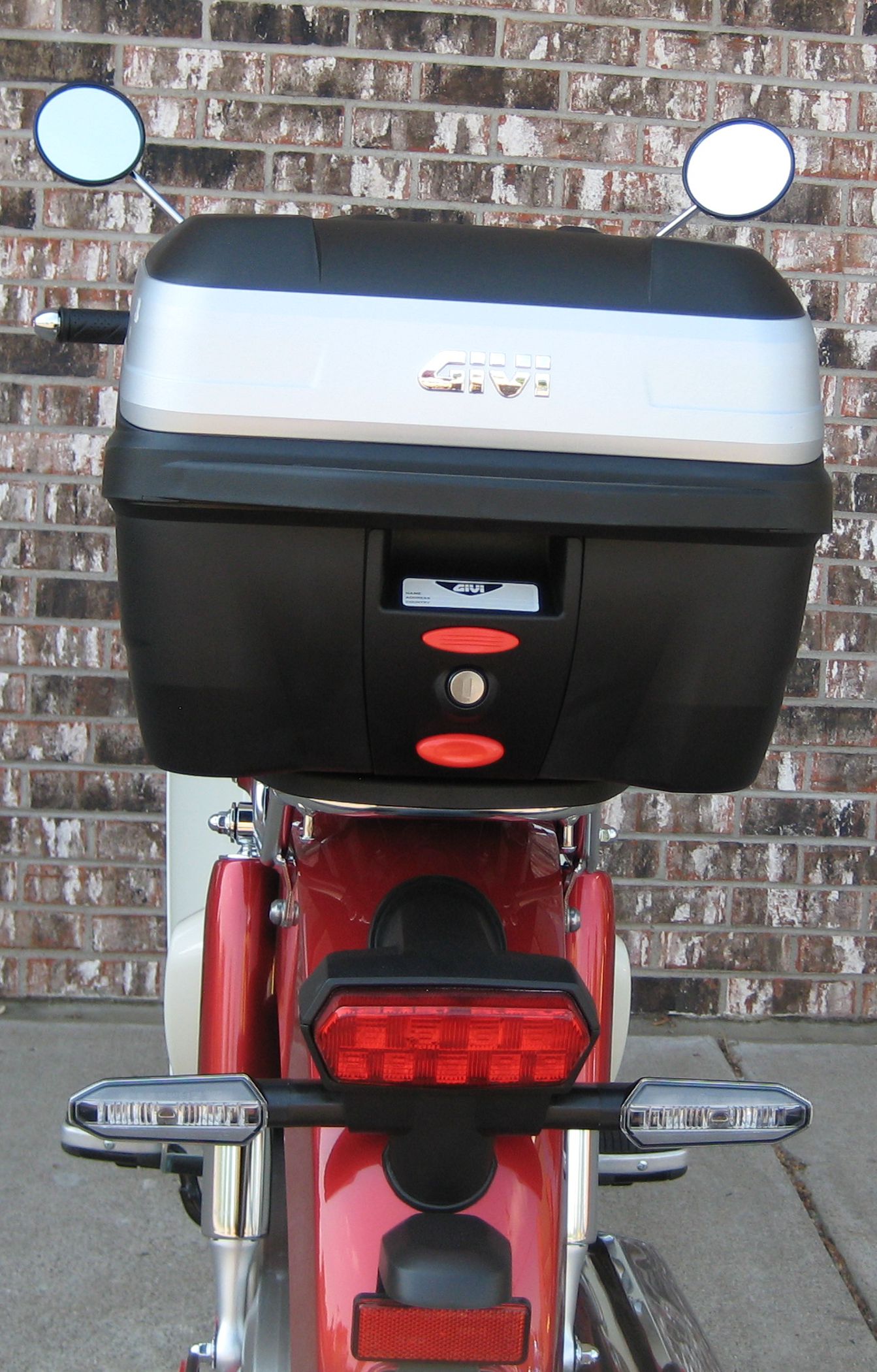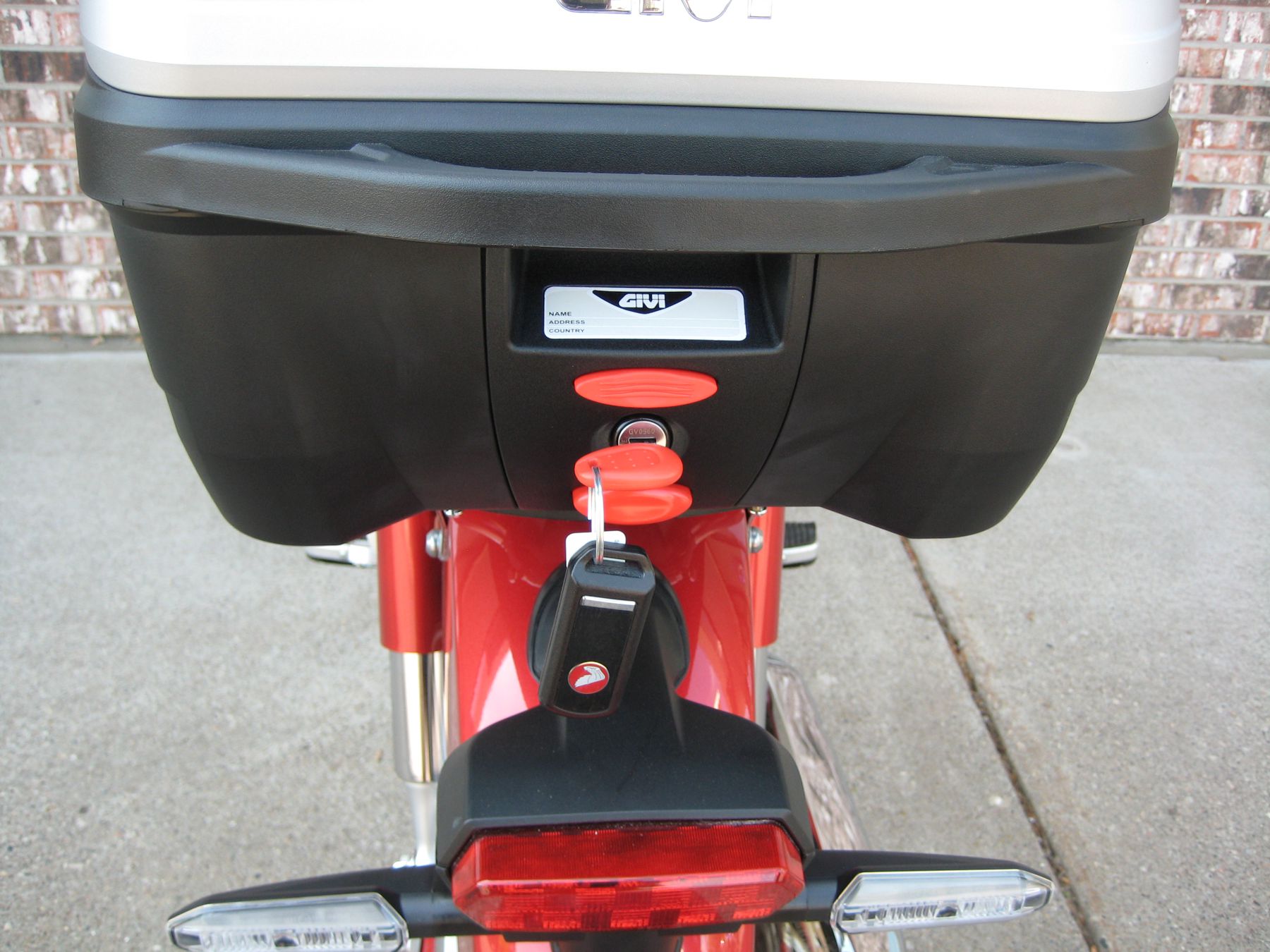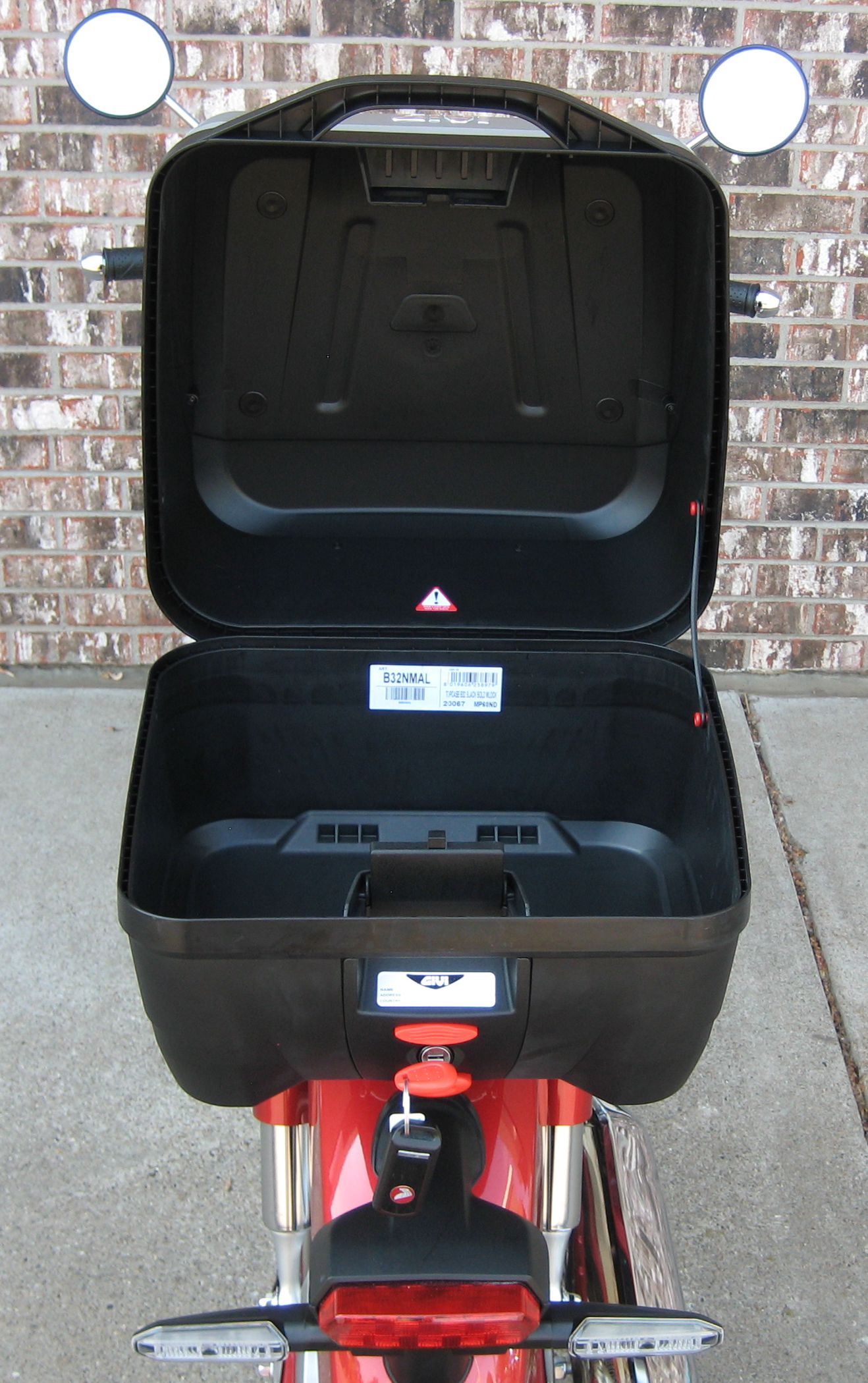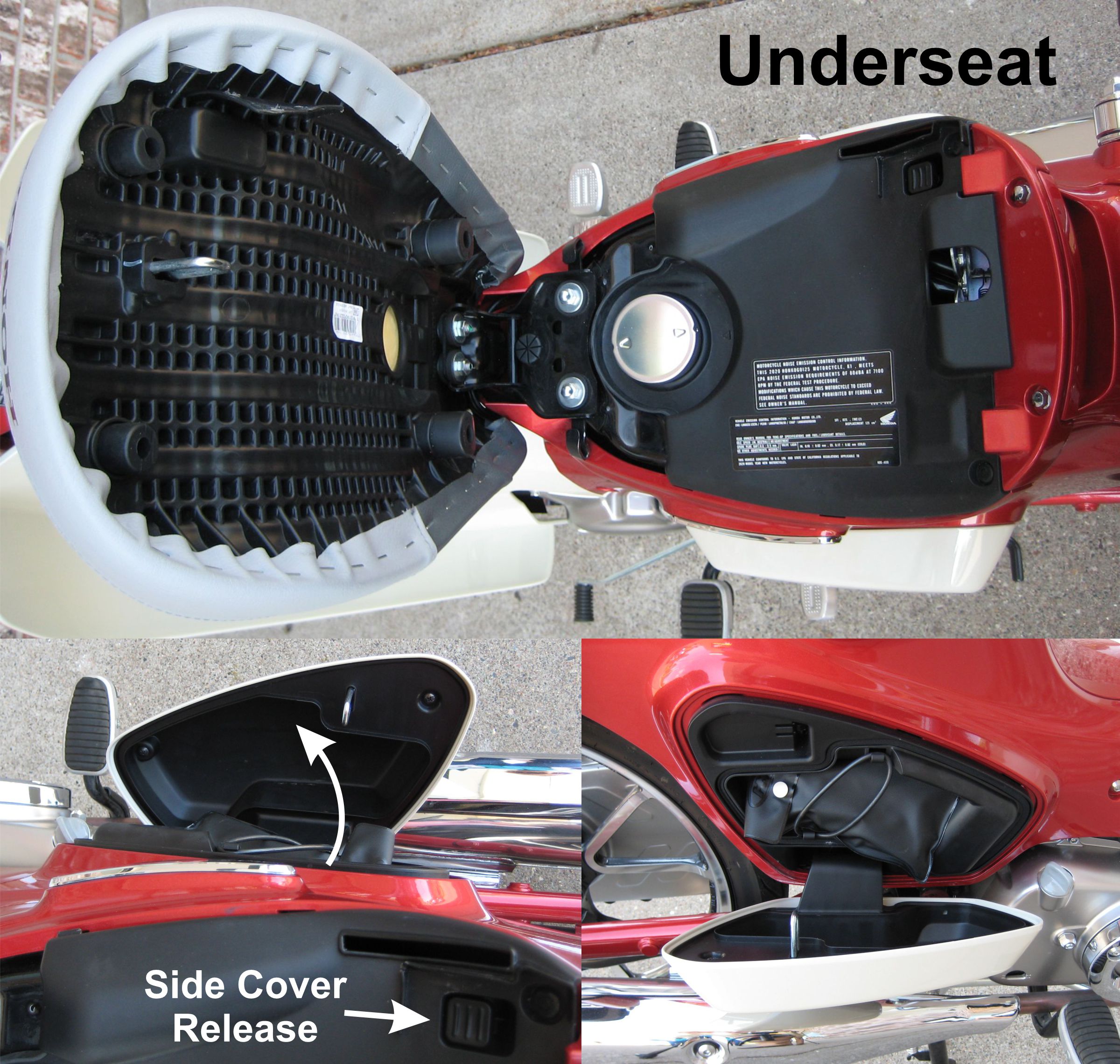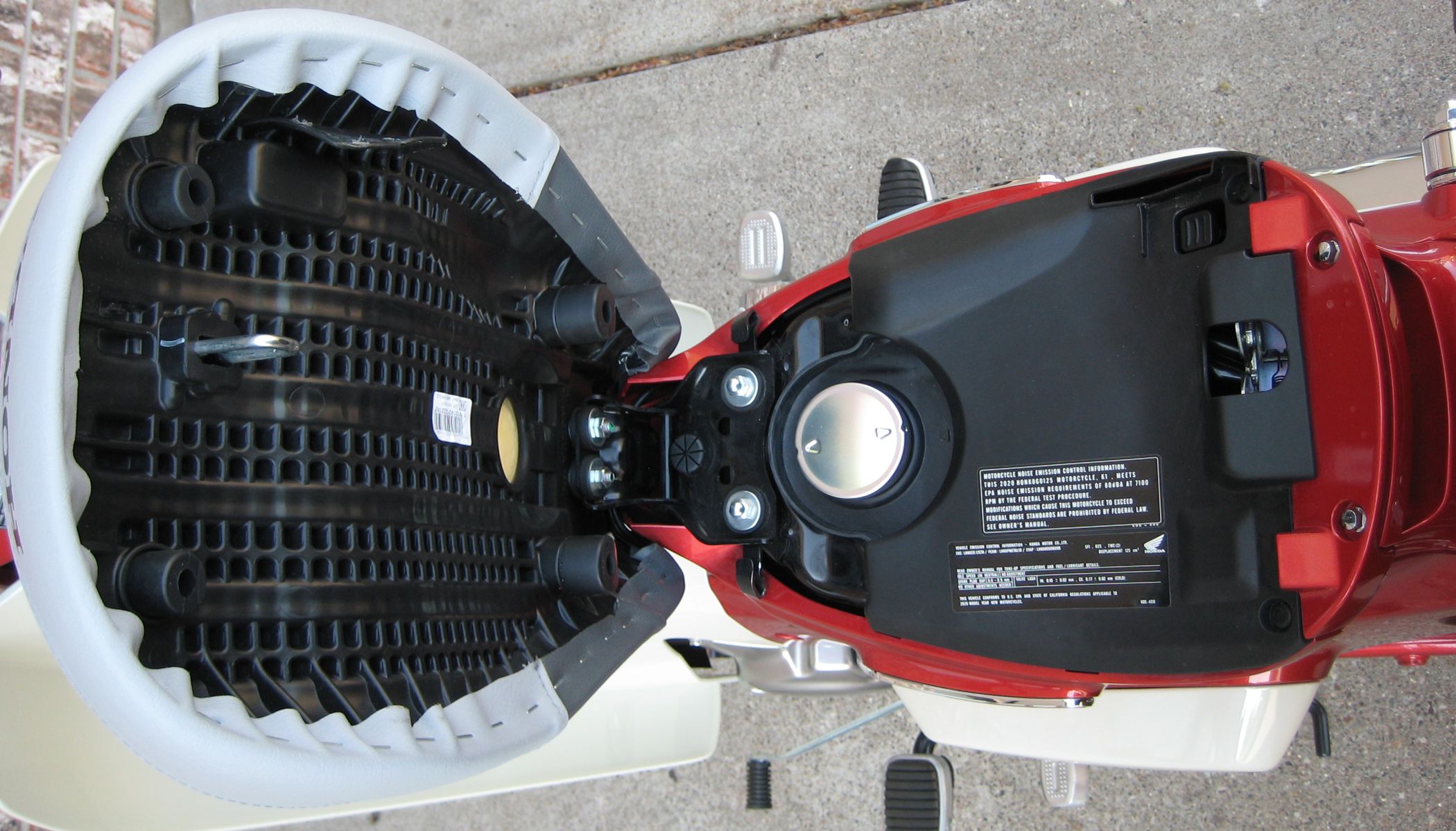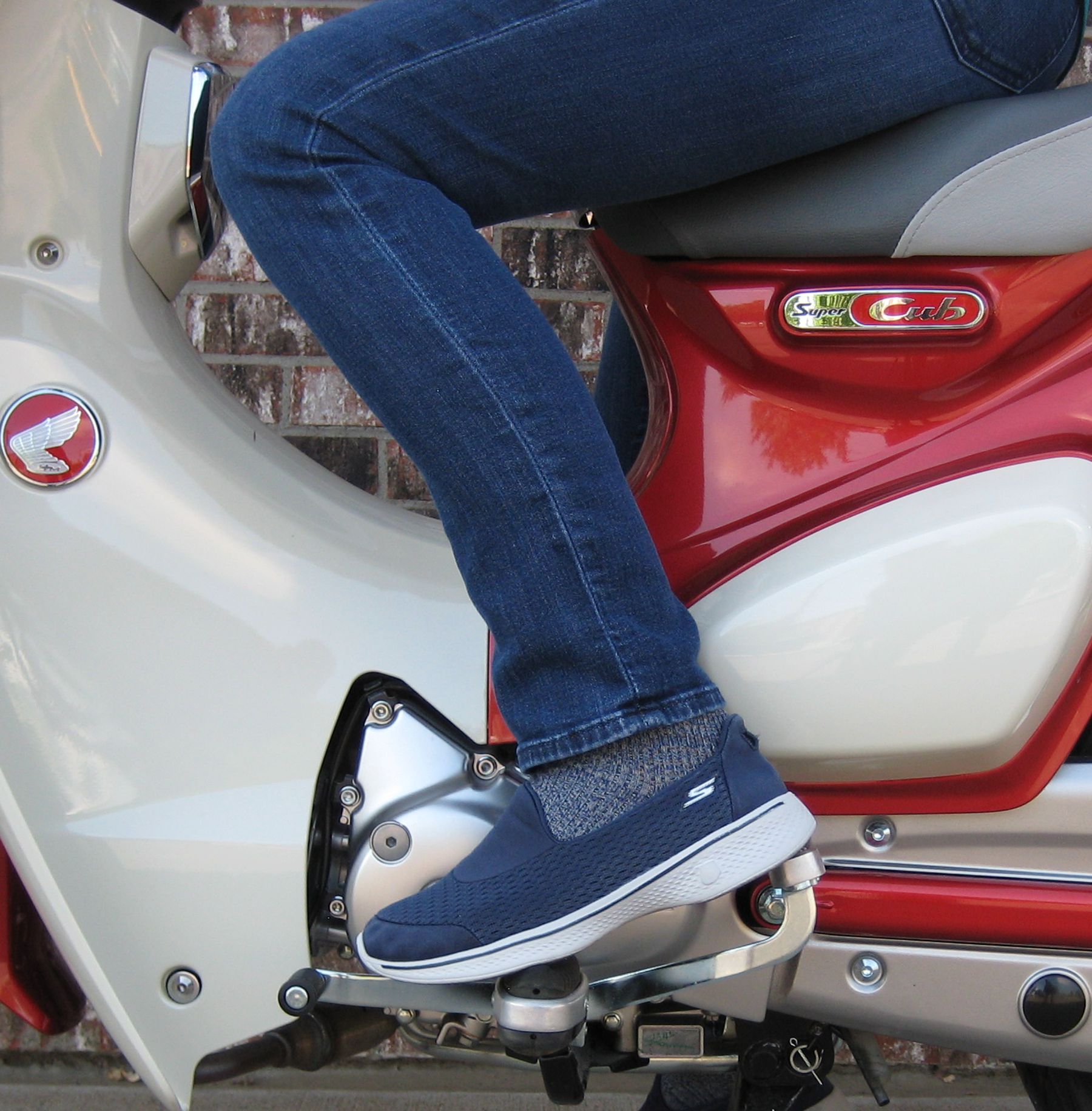Honda Super Cub
The most popular motor vehicle in the world (more than sixty million have been sold worldwide), the Honda Super Cub first hit the marketplace in 1958. The design came about after Honda founder/president Soichiro Honda and director Takeo Fujisawa went on a trip to Europe in 1956 to gather data and ideas for Honda’s next product. The popularity of small, lightweight mopeds impressed them.
Apparently, one of Fujisawa’s design criteria was that the vehicle had to be capable of one-hand operation while carrying a tray of soba noodles (couldn’t make this stuff up if we tried). The decision was made to design and build a simple to operate, reliable, step-through with a powerful (for the time) and efficient (for any time) four-stroke engine.
An automatic (centrifugal) clutch transmission was designed and (unlike the Vespa and other scooters) big wheels were selected for stability and better performance than small scooter wheels on rough or non-existent roads.
A Best-Seller
By 1961, more than one million Cubs had been sold. By 1974 that number grew to ten million. In 2008 the sixty millionth Honda Cub had been sold. My first Honda Super Cub was a 1980 or 1981 C70 Passport. That’s right, in those days a Honda Passport had two wheels, not four. It was 70ccs of reliable fun.
Though Honda has been making Super Cubs nonstop since 1958, they have not always been available in the USA. There has been a lock of new Honda Super Cubs in this country since 1983?!?!? Very luckily for us, the Honda Super Cub is back.
In recent years Honda has enjoyed sales success with small-displacement motorcycles such as the Grom and Monkey. Honda’s website even has a category for these popular small rides – miniMOTO. The Grom, Monkey, Super Cub, and Trail (Hunter) are all listed under this heading.
Oh, I’ll get a Trail at some point – no question. Probably a Monkey as well. At my age (sixty is right there, looking at me, it’s hiding behind that parked maxi-scooter) lightweight, reliable, FUN is a big draw.
As mentioned elsewhere, I am not on the list of websites that gets review machines from the big boys. I knew that I wanted a Super Cub and it was just a question of buying one. In stepped our VERY good friends at Scooterville. They took a low mileage Cub in on trade and called me right away. I took it sight unseen.
The Super Cub was in stock form and I ordered a rear rack and topcase before I even picked it up. The Honda Super Cub isn’t what most people think of as a scooter. It is also not what is commonly identified as a motorcycle. I feel it is someplace in between perhaps leaning a touch toward the scooter side.
Unlike the vast majority of scooters, it offers next-to-nothing in form of native luggage capacity. There is a tiny compartment on the starboard side for a tool kit, that’s about it. I planned to add the topcase right away and may well add some other goods carrying devices like a tunnel rack.
The voyage from Scooterville to my home gave me a chance to see right away how the Super Cub would handle a brief highway run. To get from the core Twin Cities metro area to my home I need to cover several miles at 55MPH. Yes, The Honda Super Cub can do that.
Speedometer Reading/Speed/Fuel Economy
Before winter set in, I rode a fair amount and got a good feel for the Super Cub. I did a few GPS verified checks and double-checks (in the spring) to find that the speedometer was more accurate than is normal at only 5% optimistic. Most scooters I test are 10% optimistic or worse.
At an indicated 30 MPH, the actual speed flickered from 28 to 29 MPH. At an indicated 50 MPH the actual speed flickered from 47 to 48 MPH. Pretty darn good if you ask me. On a level road with no headwind, I was able to get the Super Cub up to an indicated 60 MPH (actual speed 57 MPH) which fell to 58 MPH (actual speed 55 MPH) at a slight incline.
I am a 188-pound rider. A smaller rider may well see an actual 60 MPH which is what Honda claims as top speed. The odometer is nearly spot on with an indicated ride of 22 miles covering an actual 21 miles.
The fuel economy has been stunning. My low has been 85 MPG, my high has been 96 MPG and my average in several hundred miles has been 90 MPG. The Super Cub is least thirsty cruising at around 40 MPH without too many hills. Though I can’t claim to have kept records from the early 1980s when I had a Honda Passport, I remember that the fuel economy was in the low 80s or high 70s MPG.
Features
Transmission
Number one on the feature list for most USA buyers of the Honda Super Cub is the transmission. It is a sort of semi-automatic nearly rotary shift mostly heel/toe operated fun box.
There is no manual clutch lever (which usually occupies the left grip) but there is a foot shifter on the left side. There IS a clutch – a centrifugal clutch that engages under throttle and releases when the shift lever is pressed. All this goodness adds up to not having to fuss with the clutch lever but still enjoying the control of shifting.
People who were bothered by the manual clutch on a motorcycle like it, people who want more interaction than a fully automatic twist-and-go scooter like it.
Operating the transmission is very simple. Neutral is on the bottom, then we go through 1st, 2nd, and 3rd to get to 4th which is the top gear.
Unlike the older rotary shift Cubs, one cannot go directly from 4th to 1st, one shifts back down through the gears. The shifter is configured for heel/toe operation – step down with the heel to shift up, step down with the toe to shift down.
The shift also works like a conventional motorcycle shifter allowing one to hook one’s toe under it for upshifts. I found those motorcycle riders who had not experienced a heel/toe shifter preferred to treat the Super Cub shifter like this until they got the hand of the heel/toe method.
There is a bit of a learning curve. If one tries to shift quickly the response is harsh and jerky. Operating the shifter firmly and deliberately gives a smooth ride through the gears. The advantage of the old rotary shifter was riding along in top gear, stopping, and then shifting (through neutral) back into low gear and taking off from the stop.
One can still come to a stop in top gear and row through the gears back into low to leave the stop. Works fine, just not quite as quick and easy as the old method. The final drive is via an enclosed chain.
Powertrain
The powerplant of the Super Cub is a Grom/Monkeyesque 125cc fuel-injected, air-cooled, single cylinder, two-valve workhorse cranking out about 9 horses and 8 pound-feet of torque. Enough to move the 238 pounds (Honda says 240) Super Cub around at a comfortable though not blazing pace.
I am enamored with good fuel injection (as opposed to carburetion) and aside from a TINY touch of cold-bloodedness (I swear, Honda must engineer this into all their two-wheelers), this engine works fabulously well. The fuel tank only holds about one gallon and is located under the seat.
This is a good time to talk about one of the VERY few flaws with the Super Cub. The seat release is electric only. With the main switch turned on (and the key fob in close proximity) there is a small button below the seat on the port side that releases it. Dead battery? No seat opening function.
Under that seat, one finds the fuel filler and another release that opens the starboard side cover. Enough room in there for…… not much. That’s all the native storage on the Super Cub but more on that later.
Tires and Wheelbase
The Super Cub rides on 17-inch rubber – 70/90 in the front, 80/90 in the rear. The front suspension on the OLD Cubs was a leading link system, the new Super Cub has conventional 26mm telescopic forks. Though I liked the kind of odd feel of the old system, the new one gives a better ride and control.
The rear swingarm is managed through two shock absorbers with about 3.5 inches of travel. The front brake is a single disc and features an anti-lock (ABS) while the rear is still a drum, like the old cub. Frankly, for a bike this size, weight, and performance a rear drum is just fine by me.
The wheelbase is just shy of 49 inches. Honda says the seat height is 30.7 inches, I measured it three times and got 31 inches. We can forgive .3 inches of optimism on Honda’s part. Measured with a (188 lb) rider “compressing” the seat and suspension I got 29.6 inches to the ground. Lighting is via LED which is rapidly becoming what we expect on a new scooter or motorcycle.
I have done some night riding and the lighting is more than adequate. Visibility of the brake, signal, and headlight is quite good from other vehicles in traffic.
Instrumentation
The Super Cub instrument panel is attractive, contains enough information, and is easy to read. The round pod is made up of two circles. The outer circle contains the speedometer (biased toward miles) in the upper half and indicator lights in the lower half.
The lights cover things like turn signal operation, ABS, key presence, engine control system, high beam headlights, etc. The inner circle is a digital display (easy to see) that includes the fuel gauge, gear indicator (love this), odometer, and clock.
Riding Impressions
I love big wheels. It’s not that I don’t appreciate the quick handling of small-wheeled scooters (to say nothing of how small wheels contribute to that classic scooter look), the stability that big wheels bring is a strong contributor to the usefulness of the Super Cub. I also like the control of the foot shifter.
As such, I like riding the Honda Super Cub. Of course, I wish it was a little bit faster. Pretty sure I’ve wished that about every powered two-wheeler I’ve ridden. To fire up the Super Cub make sure the fob is in your pocket, press in on the main switch, and rotate slightly.
The fuel pump will charge and the dash will dance then just press the starter button on the right-hand controls. If cold, it may take more than one starting cycle before the Super Cub will stay running. Also when cold, it may take 90 to 120 seconds before the Super Cub will idle and run smoothly.
You should see that neutral is your current gear position on the dash, just press down firmly with your left heel (or hook your left toe and lift), notice that the gear indicator now says “1”, twist the throttle and off we go. Blip the throttle and operate the shifter purposefully and you’ll be rewarded by smooth acceleration. What kind of acceleration you ask? Brisk? Spritely? Not really. “Adequate” is the word I would select to describe the Super Cub’s acceleration.
With good shifter use, from-a-stop to about 50MPH acceleration is….. adequate. You’ll keep up with traffic just fine and won’t feel especially slow. From 50MPH to top speed will take a bit and may feel a little slow. Working with the shifter (without a manual clutch) during your ride takes a touch of finesse, but corners, traffic flow changes, and stops/starts will feel fine after a short learning curve.
I tend to downshift while decelerating on most motorcycles but found myself decelerating almost to a stop before downshifting on the Super Cub. As mentioned, on older Cubs one could come up to a stop in 4th gear and then utilize the rotary shifter to get back to first directly when leaving the stop. On the new Super Cub (approaching a full stop) I tended to stay in 4th until at about 10MPH when I dropped to 2nd and then dropped again to 1st while at the stop.
Braking is more than adequate. I haven’t as of yet explored the reaches of the front disk ABS (haven’t needed to) but in some hard/quick stops, the front disc and rear drum performed flawlessly to bring the Super Cub to a fast, controlled halt. Even on longer urban rides, I did not notice any fade.
The suspension is a touch on the soft side which does make for a comfortable though not razor-sharp-responsiveness ride. Those big wheels make the Super Cub feel more like a motorcycle than a scooter and provide a level of ride stability that couldn’t be achieved by smaller (10 or 12 inch) wheeled PTWCs. (That’s Powered Two-Wheeled Conveyances) A brisk ride on a twisty road was achieved courtesy of a good suspension and inertia.
The powerband of the motor is not such that one can aggressively push along on a twisty rapidly accelerating on-demand. Of course, to me, it would go without saying that the Honda Super Cub is not a machine for aggressive anything – acceleration, riding, or looking at.
Ergonomics are wonderful, as they should be for a design that has seen over 60 million units sold. In the USA, the Super Cub is a one-person ride. Even adding the available rear rack and pillion seat won’t change that as there are NO passenger footpegs. The OEM seat is well positioned and comfortable.
My hands and feet naturally fell onto the intended positions/controls. Once the operating methodology is practiced a bit, everything feels like it is just right. The control buttons are in easy reach and work flawlessly. The reach for the front brake lever felt perfect and the amount of pressure needed to operate it was (say it with me now) just right.
Native storage space is limited to a tiny area under the starboard side cover. Definitely more motorcycle-like than scooter-like. The Honda accessory rear rack is nice, fits well, and provides a platform for bungeeing items to the Super Cub.
The rear rack also provides a mounting point for a topcase which is what I added to my personal Super Cub. There is also a center tunnel rack available that provides a mounting point between one’s legs for more stuff. To see some pictures of extreme utilitarian cargo hauling on Cubs, get a copy of “Bikes of Burden” by Hans Kemp. Seriously, everyone who rides should have a copy of this book, it’s insane.
For now, the topcase provides enough hauling space for me to utilize the Super Cub to run errands. I suspect I’ll add a tunnel rack in the near future just to say I did.
Comparison
Yeah, this is a tough one. There aren’t really ANY direct comparison new bikes available in the USA. I’ve mentioned some comparisons to older Cubs, but one of the challenges is the odd classification of the Super Cub. Not a scooter, not a conventional motorcycle. I suppose I can make some general comparisons to both.
Honda Monkey
Beginning with Honda’s stable, the Honda Monkey is a conventional small motorcycle that is a clear homage to the Honda Mini Trail (model Z50) of yesteryear. With an MSRP of $4,199USD (ABS version), it is priced slightly higher than the Super Cub’s $3,749USD.
The Monkey is equipped with a conventional manual clutch 4-speed transmission and rides on fatter 12-inch tires (skinny 17s on the Super Cub). The chassis is smaller overall than the Super Cub and has more “compressed” ergonomics. The engine is a 125cc fuelie, just like the Super Cub. Playing on the same rock-solid “retro” card as the Super Cub, the Monkey would appeal to the old (and young) mini-bike crowd.
Not as good of a commuter as the Super Cub, the Monkey is still a wonderful machine and you’ll be hard-pressed to NOT cut through your neighbor’s yard.
Honda Grom
The Honda Grom (the current iteration has been around since 2014) is more of a modern interpretation of the minibike. Its styling is NOT at all retro, and it has spawned a whole aftermarket of enhancements and performance accessories. Specifications are very similar to the Money and the MSRP is $3,599 (2020 ABS version).
I’m no doubt showing my age, but the Grom seems like a kid’s bike to me. The 2022 version will be a new version though I am sure it will retain a lot of the older version’s looks and features.
Honda Trail 125
Last in Honda’s stable is one I really want to get my mitts on, the Honda Trail 125 (also called the “Hunter”). This is a modern take on the old Trail 90 which was a phenomenal pavement-not-required machine. VERY similar to the Super Cub, it has knobby tires, taller exhaust and air intake, rear disc brake, no bodywork, comes with a rear rack, and is geared a little lower than the Super Cub. I was hoping they would bring this machine back with the dual-range (low/high) transmission that the older Trail had but, sadly, it doesn’t. MSRP is $3,899.
Piaggo Liberty 150
From today’s scooter world I suppose an argument could be made for comparison with the Piaggio Liberty 150 (big wheels) and the Genuine Buddy Kick (small wheels).
The Piaggio Liberty 150 is one of my favorite big-wheeled scooters. With an MSRP of $2,999, the Liberty is less expensive than the Super Cub. It rides on a 16-inch front tire and a 14 inch rear tire. It is powered by a 155cc fuel-injected nearly 13 horsepower engine and gets that power to the rear wheel via a fully automatic CVT transmission.
The Liberty has a top speed of about 60MPH and when I last reviewed one I got 90 miles per gallon. There is a front glove box, luggage hook, and underseat storage native on the Liberty. Thanks to the large wheels, handling is very stable and the ride is quite smooth. Personally, I like the looks of the Super Cub more than the Liberty, but that’s just my opinion. I also find the Super Cub to be more fun to ride.
Genuine Buddy Kick
The Genuine Buddy Kick is a smallish retro-styled scooter. It has an MSRP of $3,199. It rides on 10-inch tires, has a 125cc fuel-injected engine and a fully automatic CVT transmission (twist and go). Disc brakes are provided front and rear. The Genuine Buddy line of scooters has been around for about fifteen years and has a well-earned cult following.
The Kick is a touch different than the old line-up of Buddy models, but its specifications are more in line with the Super Cub. It is quick accelerating with a top speed of about 55MPH and “nimble” is not a strong enough word to describe the handling. That’s a benefit of those smallish wheels. It seems like one just thinks about turning and it happens, very quickly.
The downside to that is a less stable ride, less absorption of imperfect roads, and less rider comfort. There is native storage on the Kick and a plethora of accessories to increase hauling capacity. Oh, yeah, it is CUTE. When it came time for my adult daughter to get a scooter, it was a Genuine Buddy Kick. As easy to ride as any 50cc scooter with infinitely more performance.
Fit & Finish
It is a Honda Super Cub after all so my expectations are high so far as fit and finish goes. Once again, Honda has met (or exceeded) my expectations. Component quality is excellent. Every switch, button, lever, etc. looks and feels high quality. The paintwork, body panel fit, seat, all top-notch.
Based on my experience with many Hondas, I fully expect the Super Cub to have a long useable life, be reliable and inexpensive to maintain.
Conclusions
The fuel-injected automatic clutch big wheel Honda Super Cub is a wonder of the transportation world. As long as you don’t expect freeway touring capability or two-up riding, this is a remorse-proof choice.
My suggestion would be for you to RUSH to your Honda dealer and immediately get a Super Cub AND a Hunter (Trail 125)…… NOW! Here in the Twin Cities area of Minnesota, availability has been a big challenge. I’ve said it rather more than once in the review – the Honda Super Cub is just right.

